
|
|
|
|
|
|
SU HD8 carburetor
This carburetor, removed for service, shows the early style brass-top dampener.
|
|
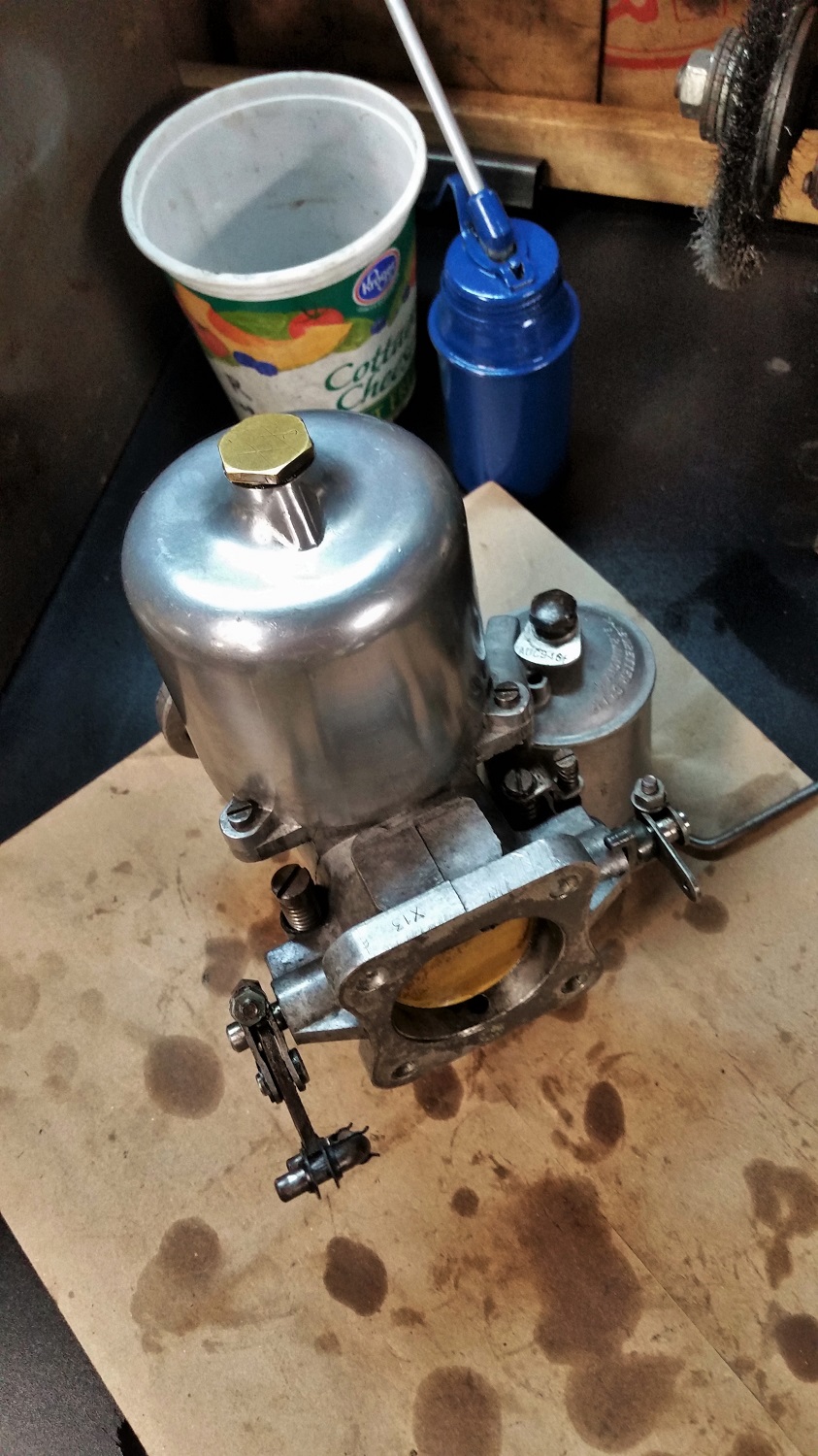
|
|
|
|
|
|
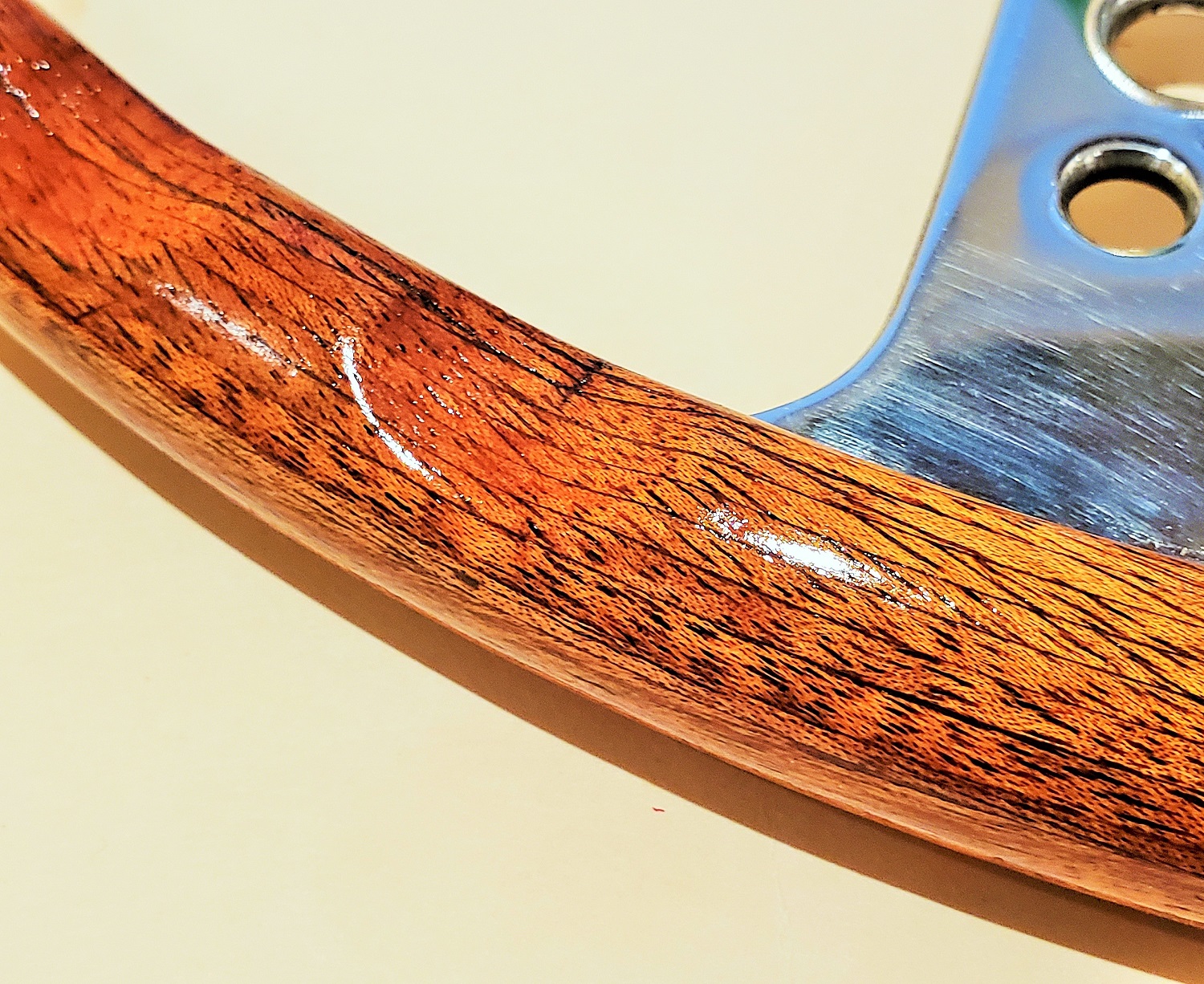
|
|
Steering wheel
This view of an E-type steering wheel shows its laminated-wood construction.
|
|
|
|
|
|
Early Series 1 glass windshield washer bottle
After de Chirico.
|
|
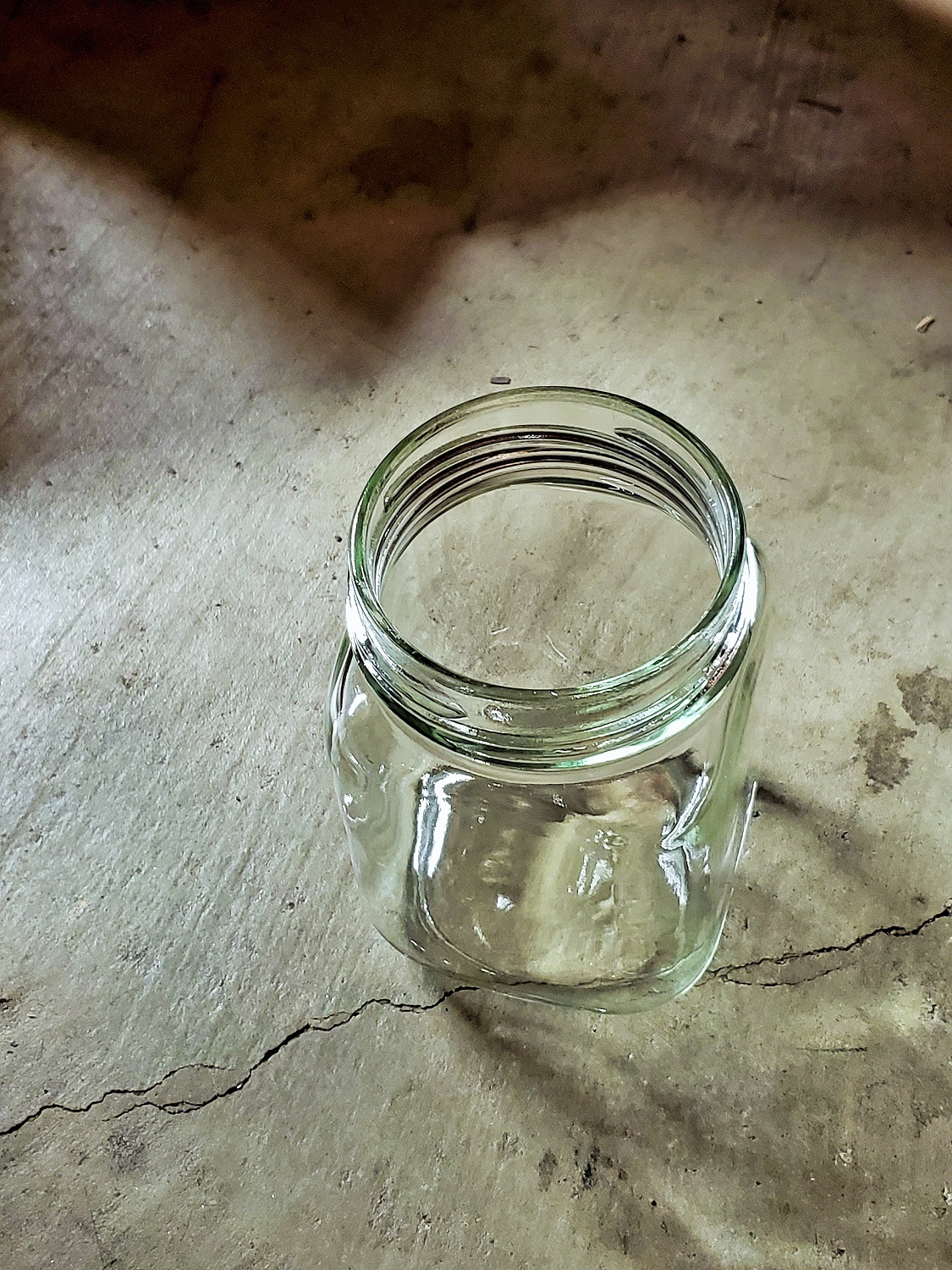
|
|
|
|
|
|
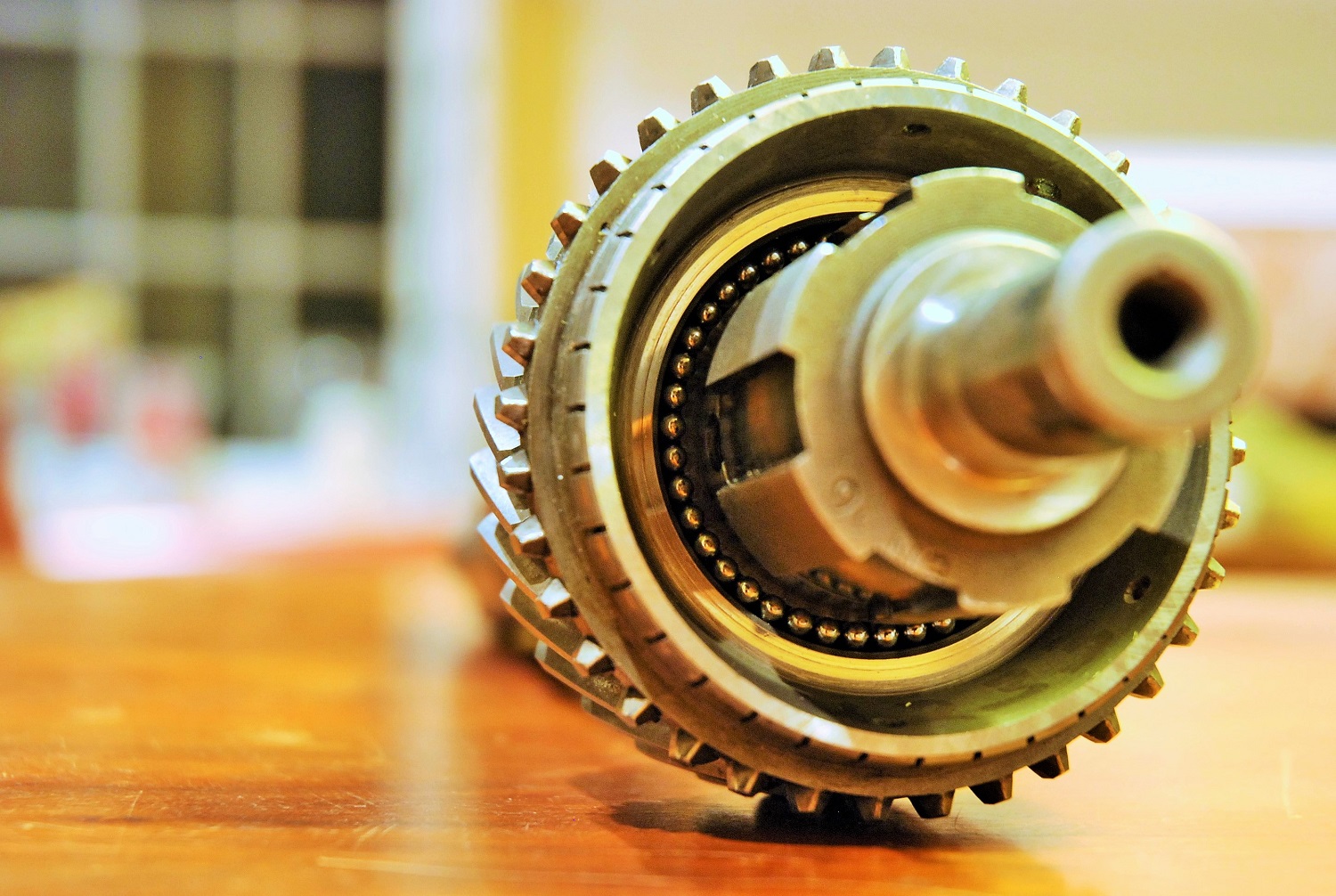
|
|
Third gear needle bearings on a Moss gearbox
The ends of the needle bearings between third gear and the output shaft are seen here.
The part of the output shaft in the foreground is where the shaft inserts into the constant pinion shaft.
There will be needle bearings at this juncture as well, but they are caged, as opposed to the third-gear needle bearings seen here that are free.
|
|
|
|
|
|
Heater blower fan
Forced air for ventillation and heating was driven by this cylindrical fan. It was powered by a motor, mounted below, and not visible in this picture.
Here the fan and motor have been lowered out of their housing in the heater unit, located just above.
This particular motor had not run in over 50 years, but is seen here working well after the wiring was corrected.
|
|
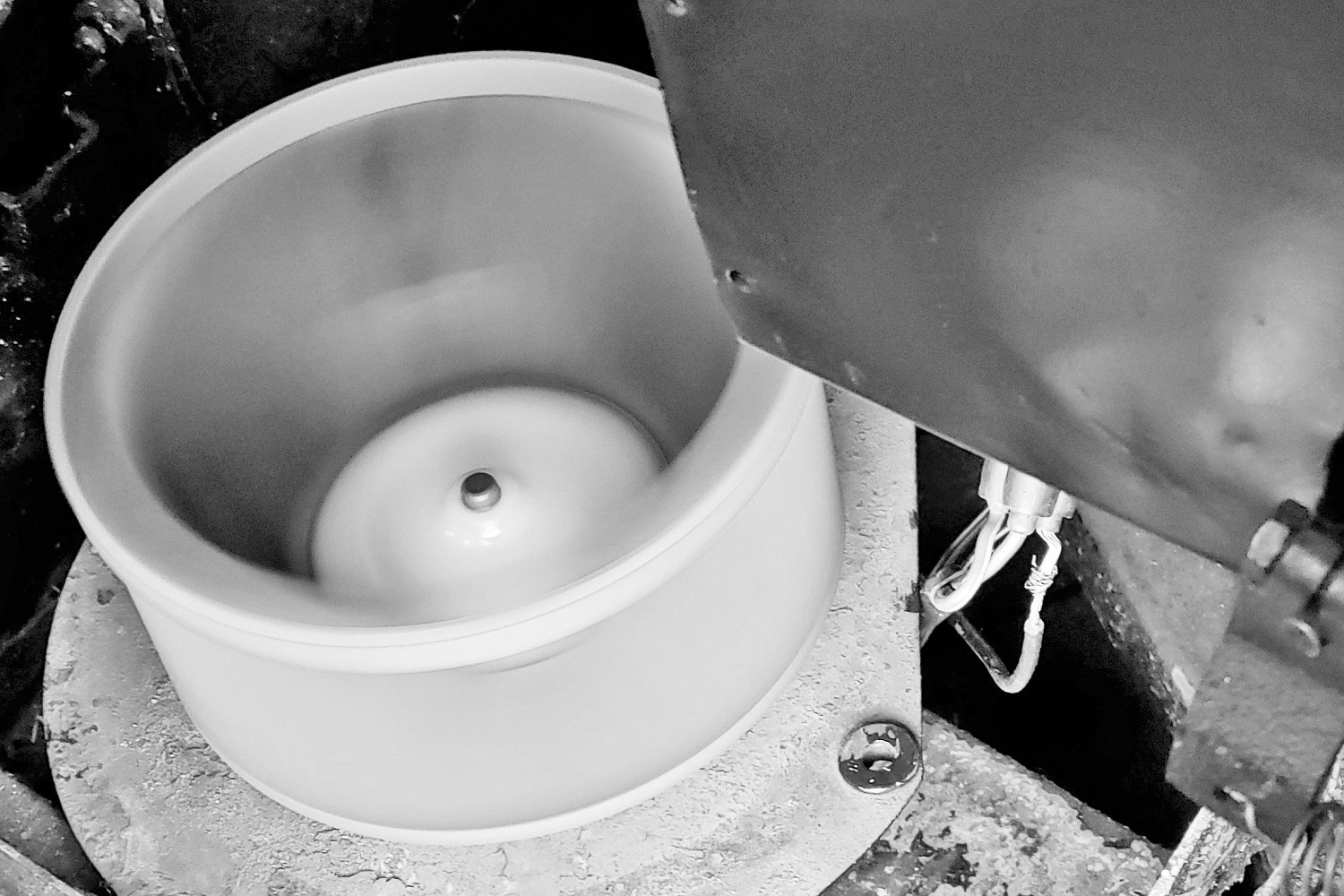
|
|
|
|
|
|
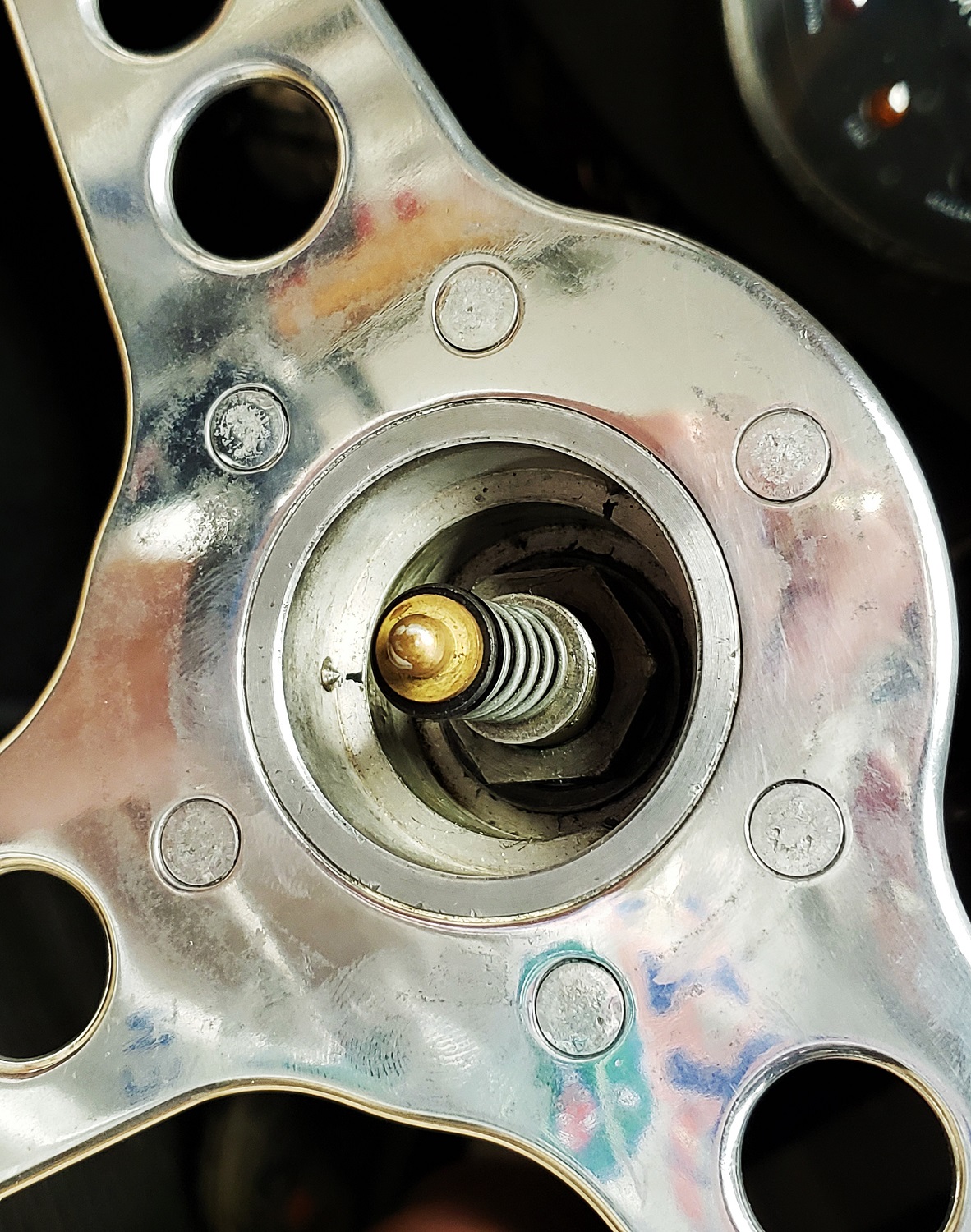
|
|
Steering wheel hub
The E-type's steering wheel had an aluminum frame. On the Series 1 cars, the horn was actuated by the button in the center of the steering wheel. Pressing the button grounded the brass rod running through the center of the wheel.
Later, horn actuation was moved to a button on the end of the turn-signal stalk.
|
|
|
|
|
|
Broken damper assembly
This late-style damper assembly from a HD-8 S.U. carburetor was removed from a Series 1 two-seater coupe just after its failure had been discovered.
The plastic top had broken, permitting the damper rod to push through the top. The damper assembly (on the lower left in the picture) then pushed the rod up, and this was was noticed by the owner.
This is a relatively common failure mode for the plastic-topped dampers. The plastic design appeared on E-type HD-8 carburetors in mid-3.8-liter production, replacing the earlier brass tops. The plastic tops were introduced on other S.U. carburetors at about the same time.
The brass tops used on earlier E-types do not show this failure mode.
|
|
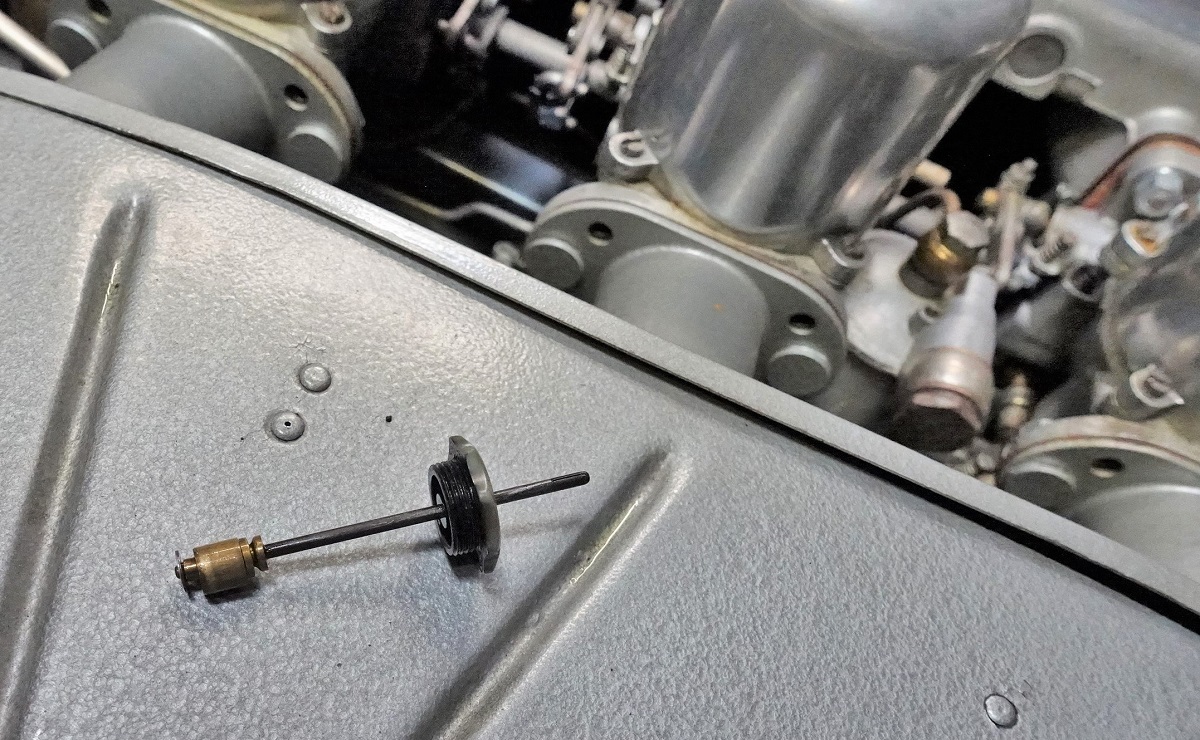
|
|
|
|
|
|
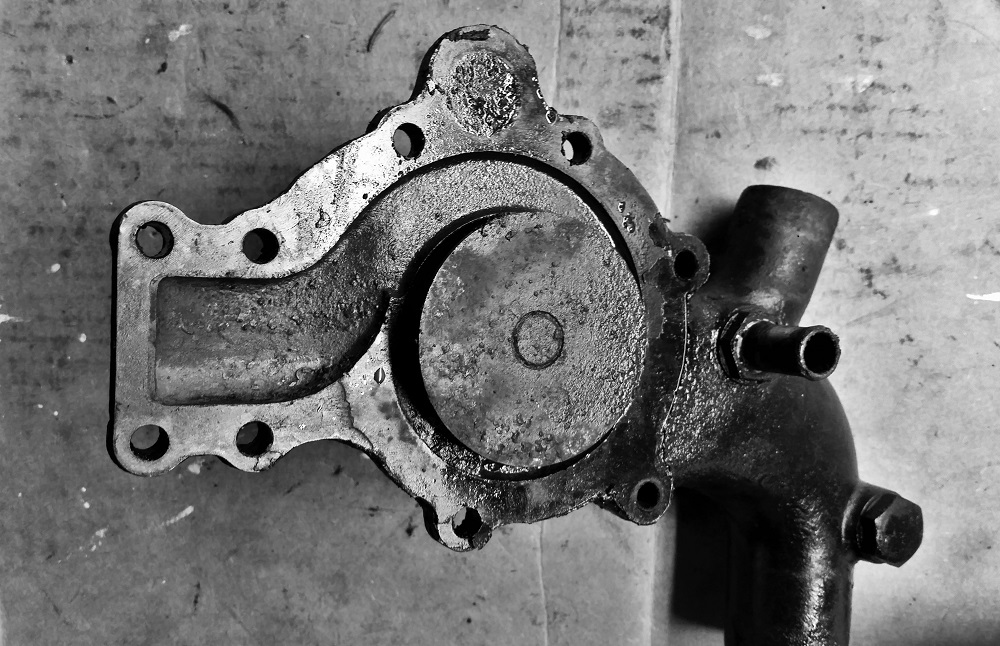
|
|
Water pump
This water pump has just been removed from a 3.8-liter XK engine and is still wet with anitfreeze. The back side of the round impeller is seen, with the end of the waterpump driveshaft in the center.
The curved path in the housing for the cooling liquid (propelled out from the impeller as it is spun by the driveshaft) wraps around the impeller, and ends on the left-hand side of the picture. The channel terminates over a rectangular aperture in the timing-chain cover, into which the cooling liquid then flows. From there it enters a long channel running along the top left side of the engine block, and then flows into the cooling jackets.
|
|
|
|
|
|
Dash plaque on the last E-type
The last E-types produced (V-12 Series 3 cars) carried commerative plaques. The very last E-type produced carried this special plaque.
This is a similar-looking plaque to those used on early XK-120 roadsters (except the first few), and on XK-140 roadsters, describing their performance.
|
|
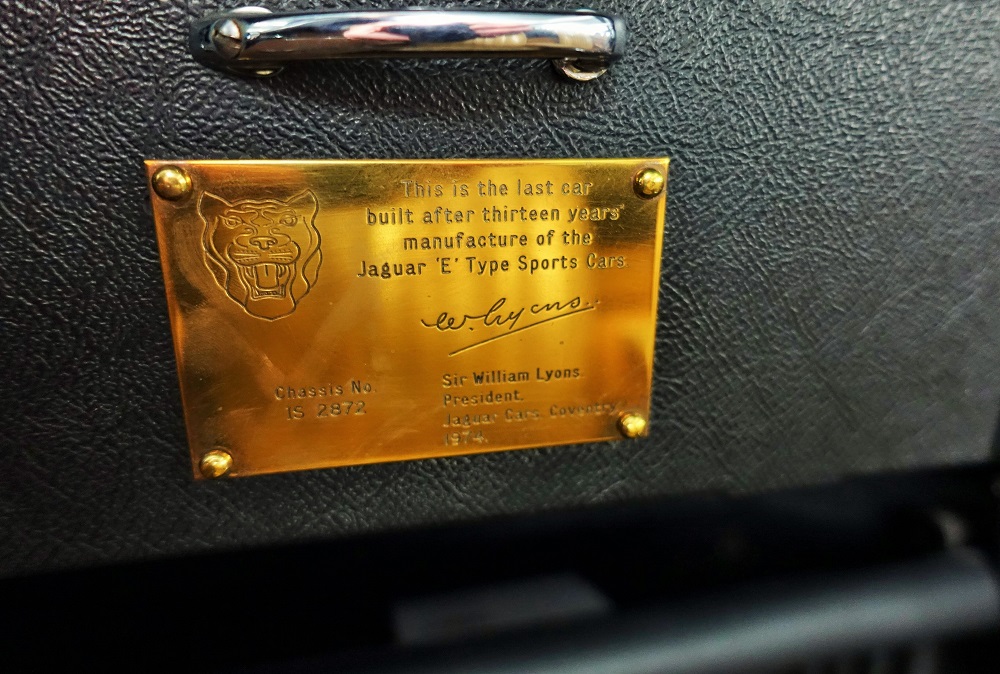
|
|
|
|
|
|
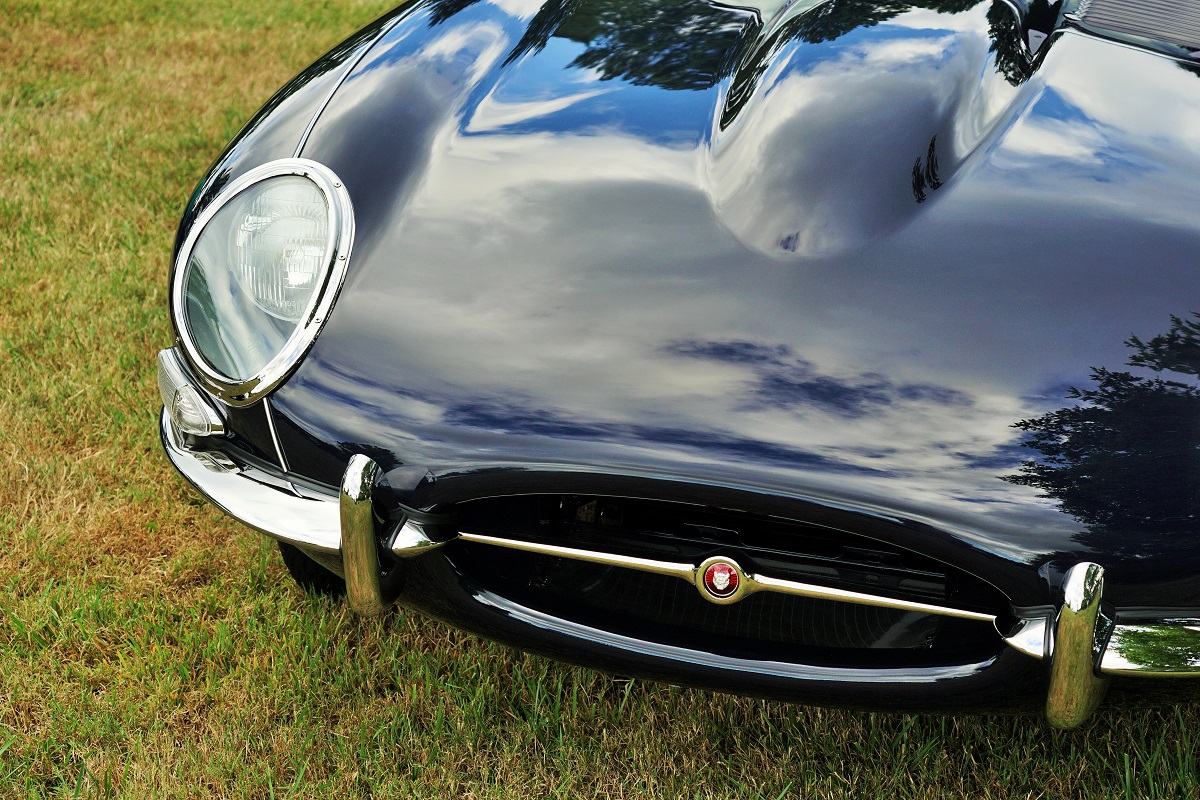
|
|
Front-view, Series 1 E-type
A nicely-restored car sitting on the grass at a concourse.
|
|
|
|
|
|
Left-hand side view of the S-type XK engine, as fitted to the E-type Jaguar
View of the polished aluminum cam covers, intake manifold components and S.U. HD-8 2-inch throat carubretors.
Although it was over ten years old in 1961 when the E-type was introduced, it was still an advanced design for the day.
|
|
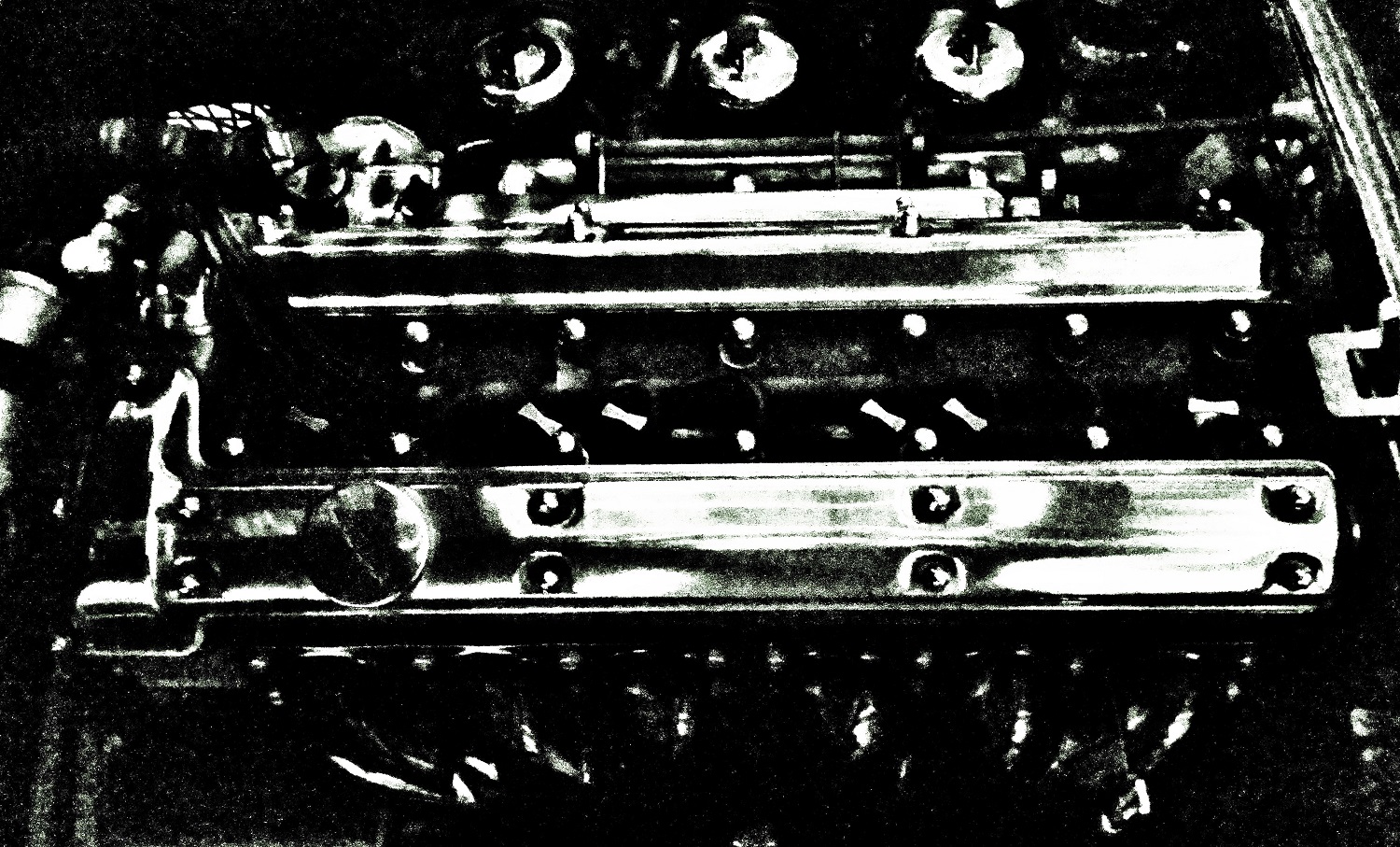
|
|
|
|
|
|
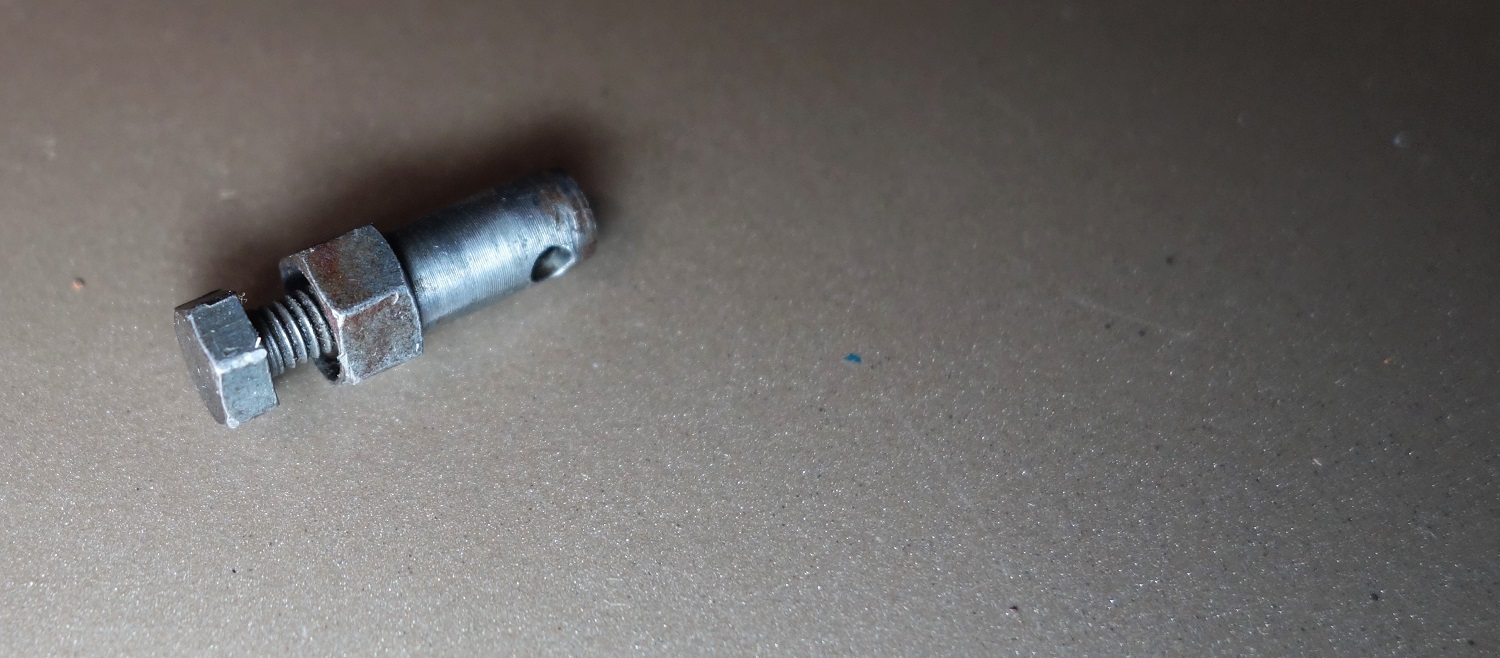
|
|
Choke cable adapter
This small part attaches the end of choke control cable to the choke control rod on the bottom of the center carburetor.
It is one of hundreds of attractive small details that make up the E-type Jaguar.
|
|
|
|
|
|
Top of the timing chain assembly
The intermediate gear tensioner is in the top of the picture.
In the top left of the picture the West Yourkshire Foundry mark can be seen in the cast aluminum.
|
|
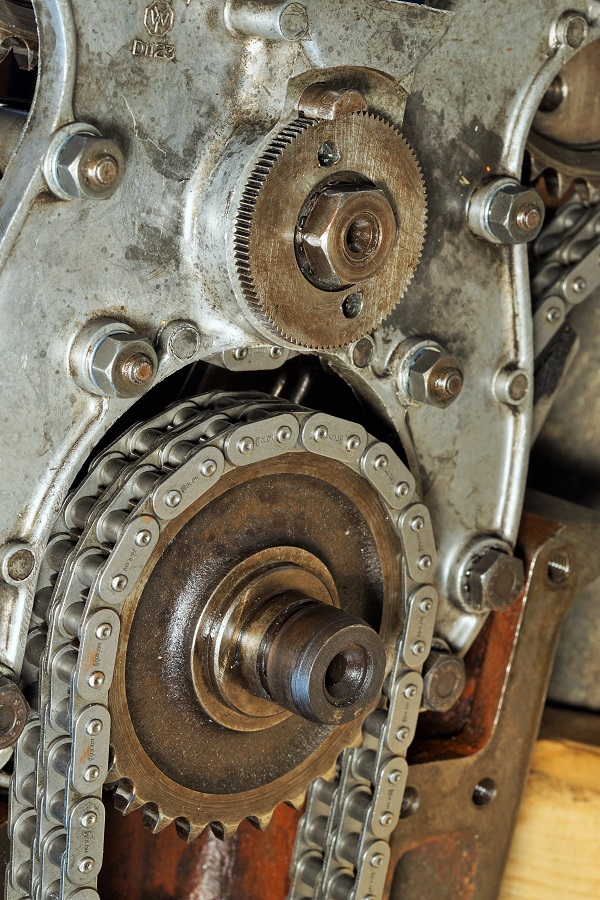
|
|
|
|
|
|
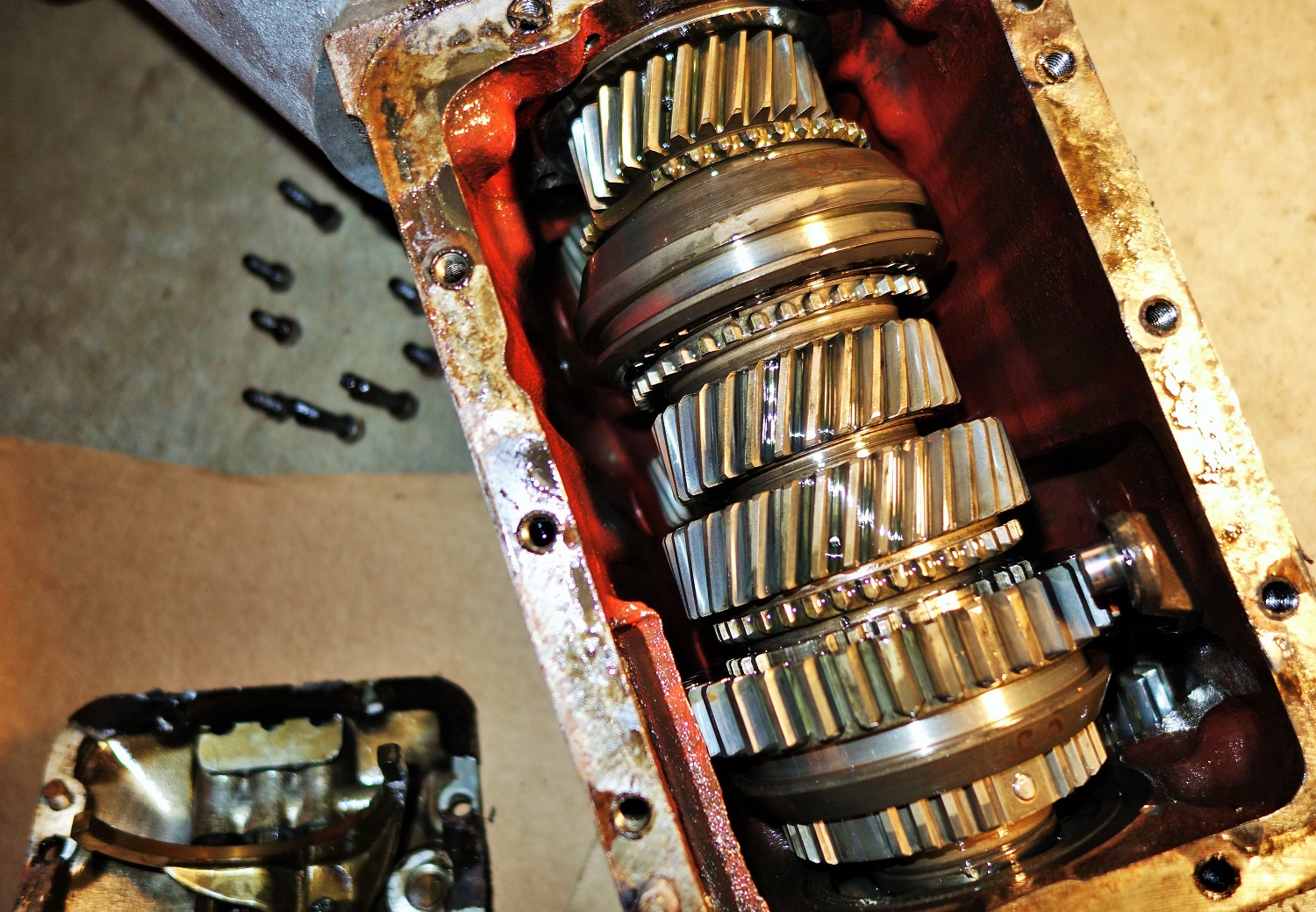
|
|
Moss gearbox with cover removed
The gears had just been turned before removal of the cover. Oil can be seen seeping back down in to the case.
|
|
|
|
|
|
Faced-off block deck on 3.8-liter XK engine
Head studs and pistons have been replaced during this rebuild.
|
|

|
|
|
|
|
|
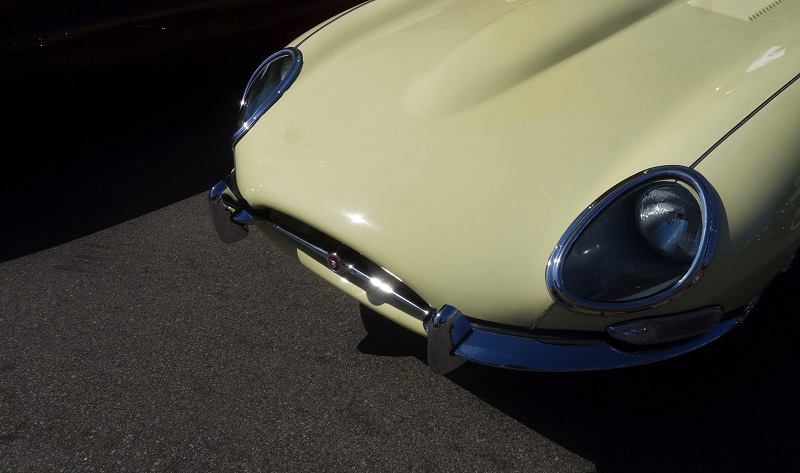
|
|
Later style Series 1 bonnet
Early Series 1 bonnets had the headlight nacelles in body color.
Later on during 3.8-liter production they were silver.
|
|
|
|
|
|
Magritteian view from passengers side of a Series 1 E-type
View down the road at dusk.
|
|
.jpg)
|
|
|
|
|
|
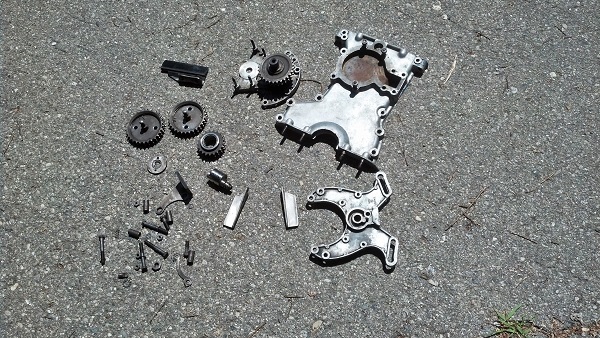
|
|
Timing gear and cover from XK engine
Some of the components from the complex and clever timing gear system used on all XK engines.
|
|
|
|
|
|
Generator from 3.8-liter E-type
This generator is of the later 3.8-liter type with a smaller outside diameter than the earlier generators.
The original generator color was a semi-gloss black as opposted to the reddish paint now on this generator.
|
|
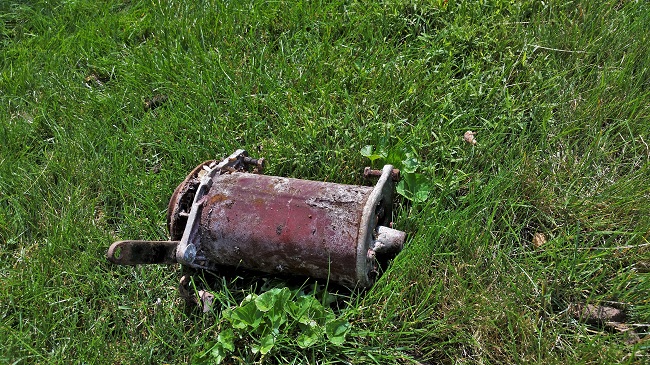
|
|
|
|
|
|
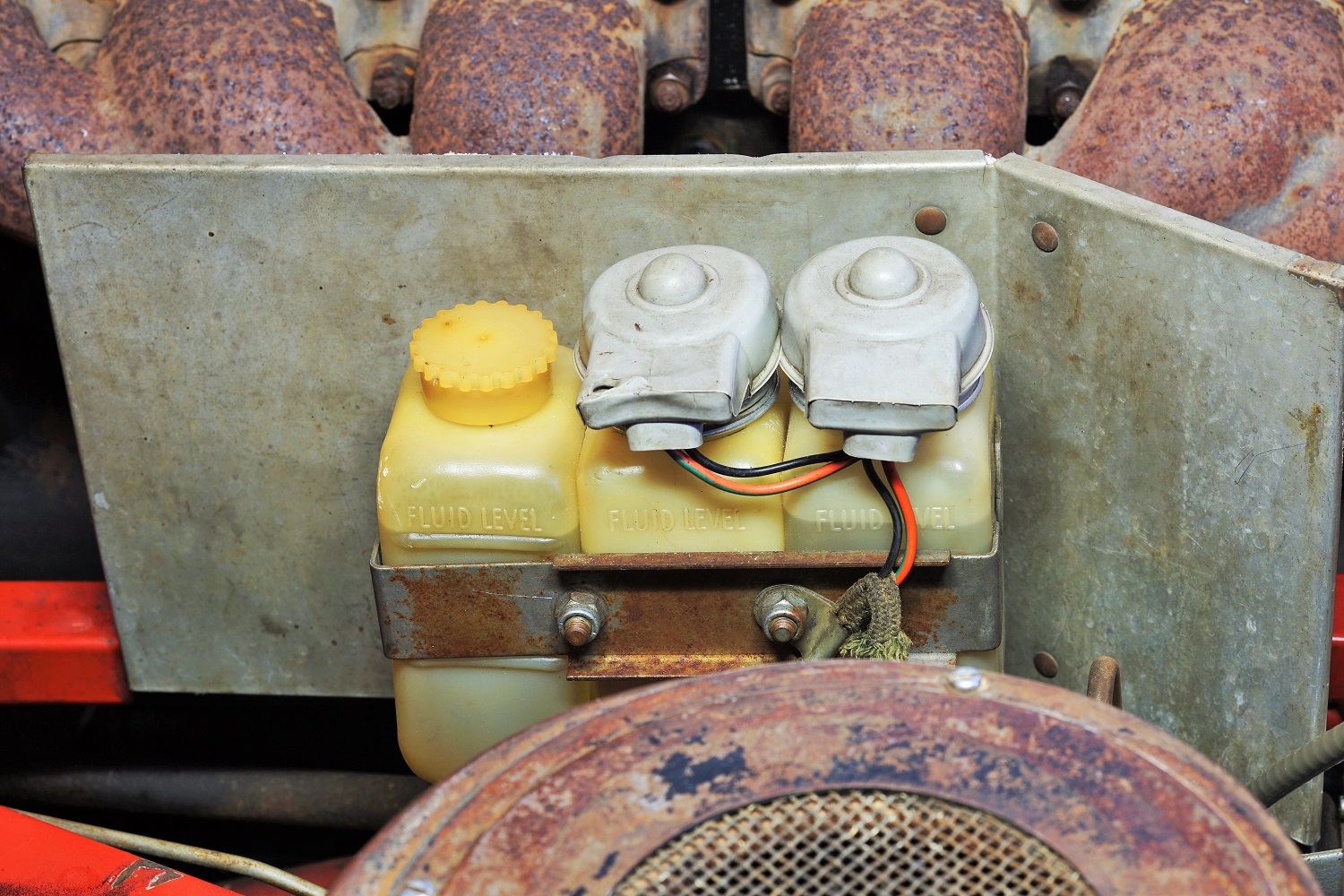
|
|
Clutch and brake reservoirs
The later brake and clutch fluid reservoirs were rectangular in shape, as opposed to the cylindrical shape of the earlier reservoirs.
Another feature of later 3.8-liter cars is the elastomeric covers seen on the right two (brake) reservoirs. These same covers were used on 4.2-liter cars.
|
|
|
|
|
|
Setting cam timing
This cam-timing tool was included in some E-type toolkits. It fit over the flanges near the front of the two camshafts and put them in the TDC position.
Here the tool is being used on the intake cam of a 3.8-liter E-type XK engine. The tang on the tool can be seen inserted in the notch machined in the flange on the cam. This positions the cam.
|
|
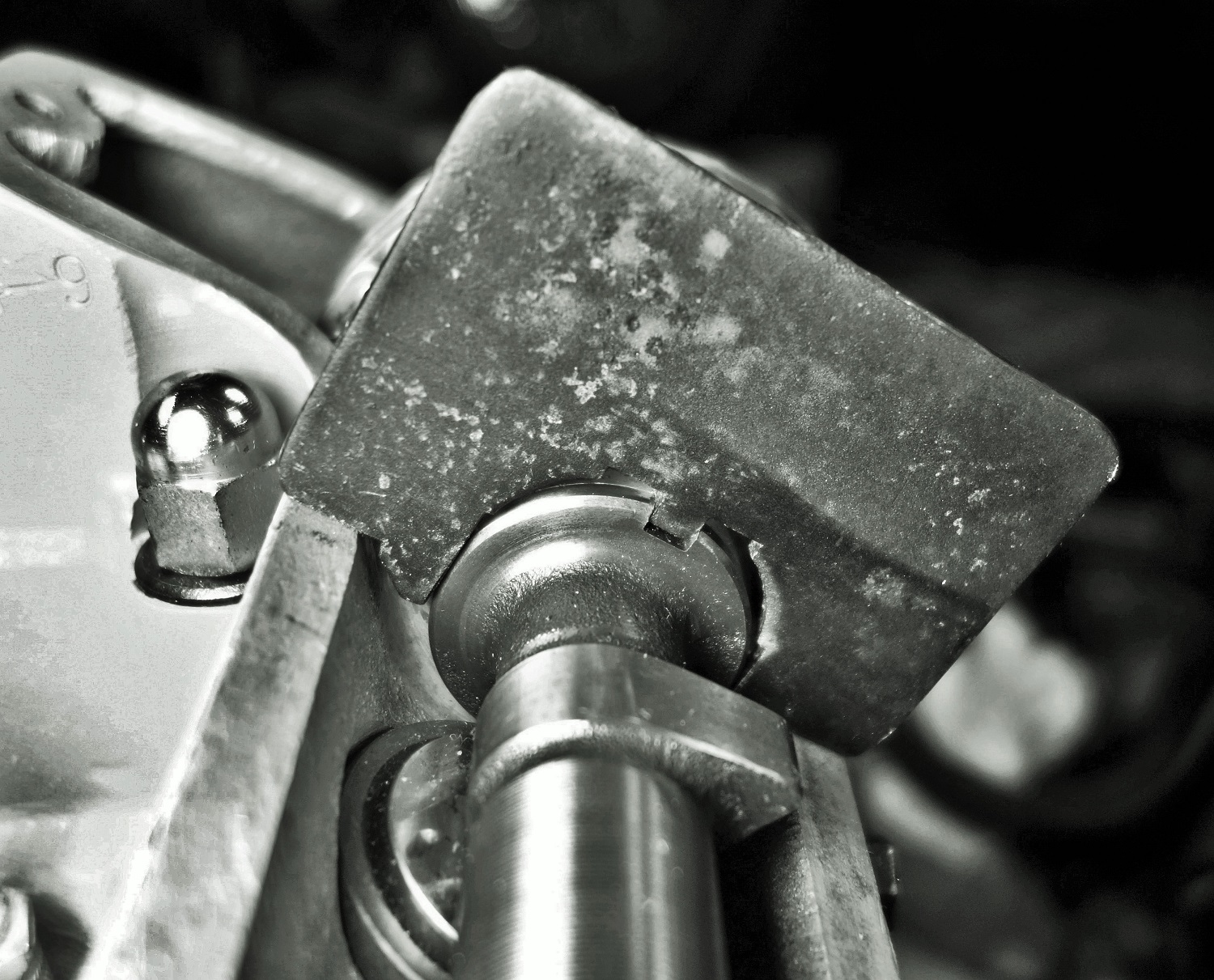
|
|
|
|
|
|
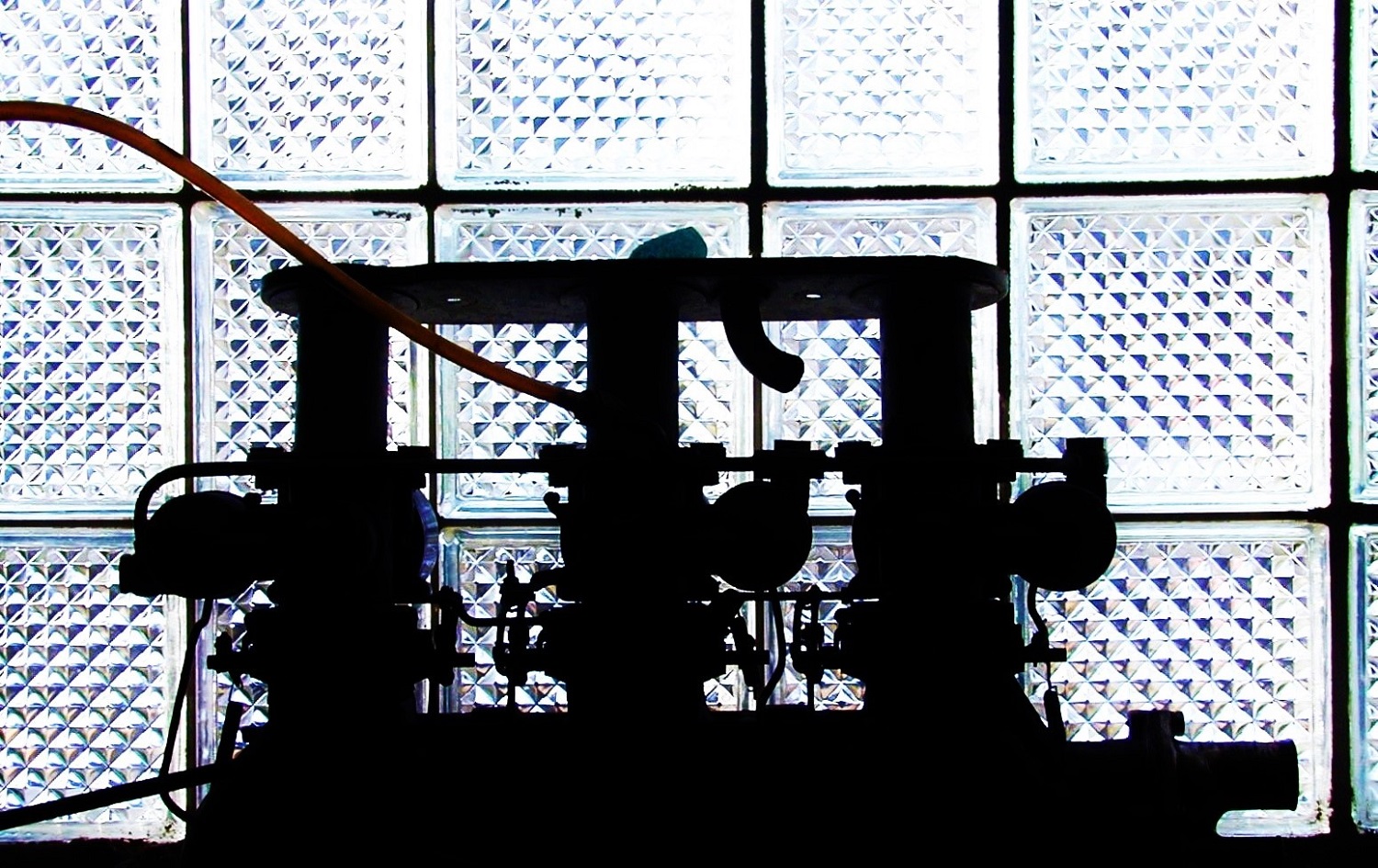
|
|
E-type carburation
Until the introduction of the Series 1.5 in 1968 all E-types had three SU HD8 carburetors, as seen here.
For markets outside U.S. these carburetors continued for a while, but finally dual Stromberg carburetors were used on all E-types, regardless of market.
|
|
|
|
|
|
Bottom end of the XK engine
The XK engine has a seven main bearing cranksahft, giving an extremely sturdy bottom end.
This is just one of the aspects of the XK engine that enabled it to acheive five outright wins at Le Mans.
|
|
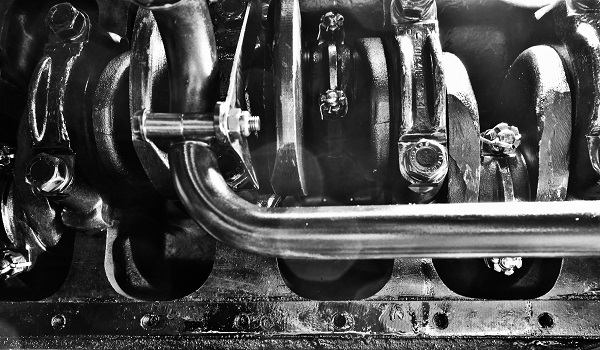
|
|
|
|
|
|
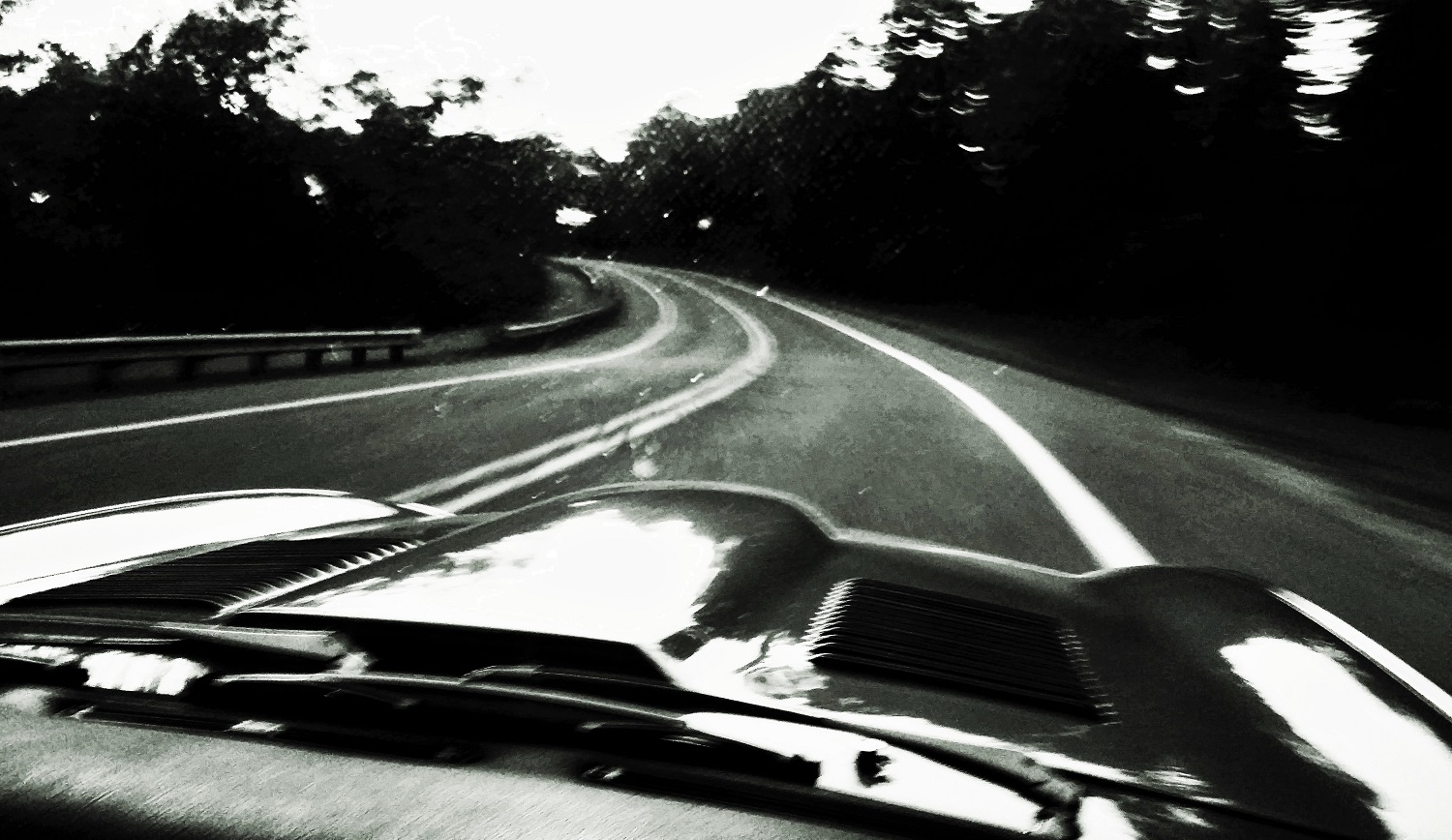
|
|
View down the road . . .
This is perhaps the most attractive view down the hood of any prodution sports car.
|
|
|
|
|
|
View of a late Series 1 console
This view of a restored console area on a late Series 1 car shows the 4.2-liter type shift knob. This is disucssed in more detail on pages 288 to 294 of the newOriginality Book.
While much evolution had occurred in this area over Series 1 production it still basically retains the classic appearance.
Rocker switches were shortly to appear.
|
|
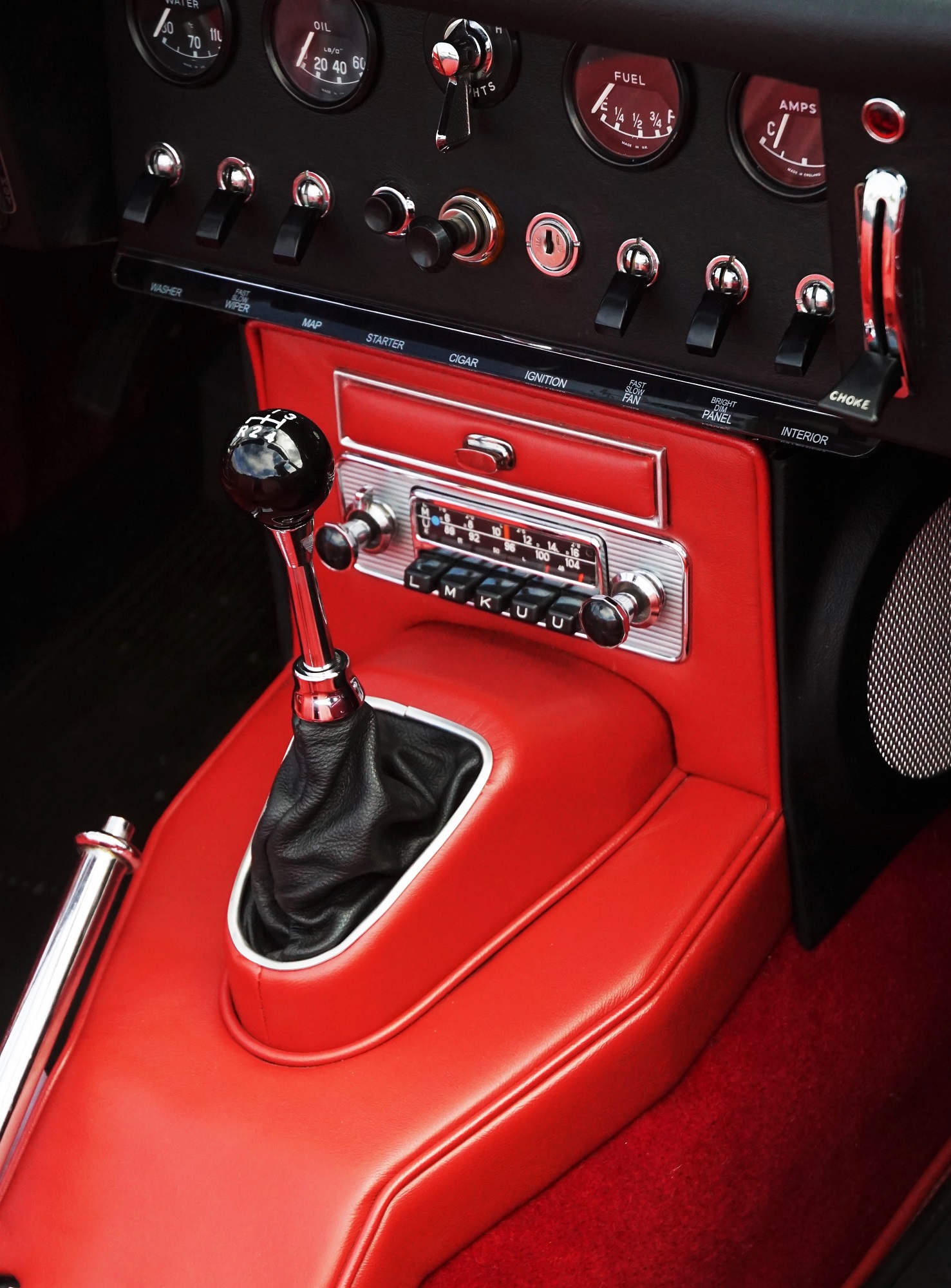
|
|
|
|
|
|
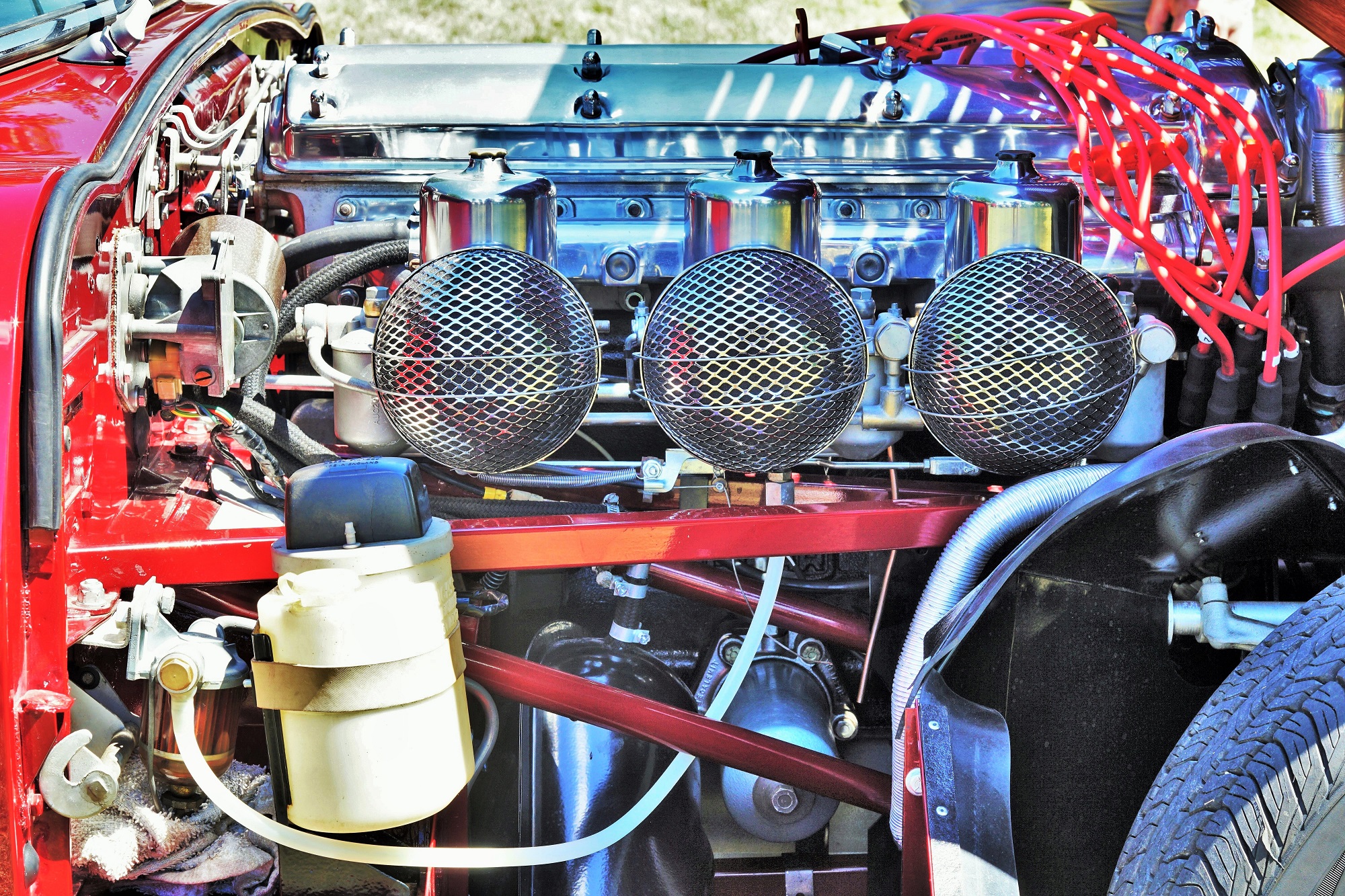
|
|
Upgraded Series 2
This Series 2 has been modified with the additon of the earlier polished cam covers and the three HD8 carbs.
This is a relatively common modification.
The individual air cleaners and red plug wires are additions from outside the realm of anything Jaguar shipped on their production E-types.
|
|
|
|
|
|
Trunk lid badge from early E-type
The last letters of this early-style badge shows the squared off profile shapes of the letters.
In later 3.8-liter E-type production more rounded letters were used. This has been a feature often overlooked in restorations.
This is disucssed in more detail on pages 56 and 57 of the newOriginality Book.
|
|
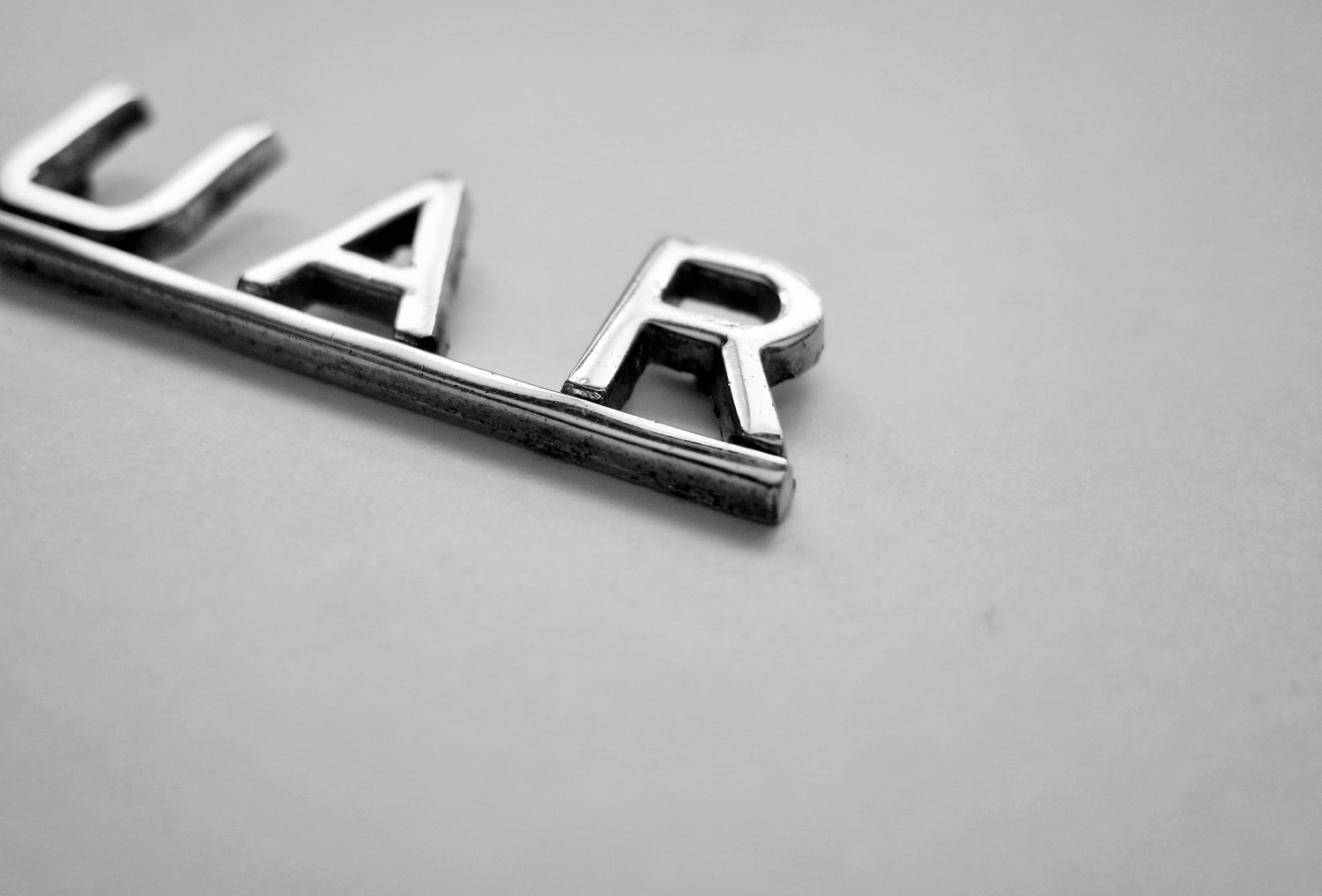
|
|
|
|
|
|
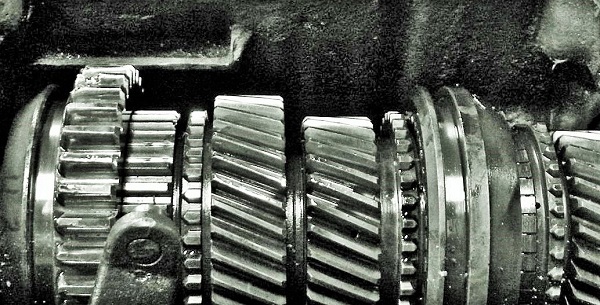
|
|
Teeth in a Moss-type gearbox
The 3.8-liter E-types used a gearbox of the Moss design, but made by jaguar. Here the straight-cut spur gear teeth of the first gear (far left), that also actuated reverse, are seen.
The helical gear teeth of second and third gear are seen in the middle. On the far right is the helical gear on the constant pinion shaft that takes input motion from the clutch disc and turns the layshaft from which first, second, third and reverse are selected.
Fourth gear is a straight-through gear, where the constant pinion shaft directly drives the output shaft. The layshaft is still driven by the constant pinion shaft, but in the fourth gear case the layshaft is not driving the output of the transmission.
|
|
|
|
|
|
Aluminum wood-rimmed steering wheel
These are sometimes referred to as "Duncan Hamilton" wheels, after Jaguar's famous Le Mans winning driver.
This is one of the most beautiful and classic of post-war sports-car steering wheels.
|
|
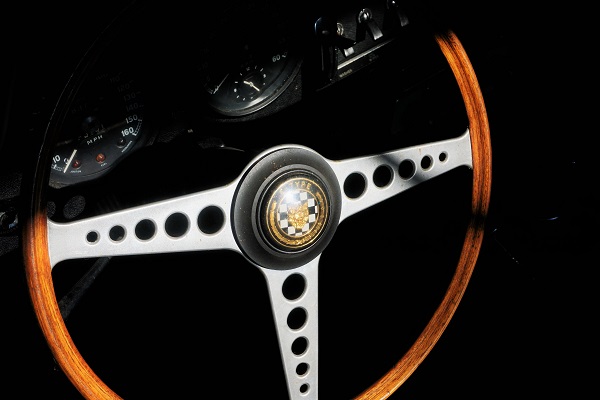
|
|
|
|
|
|
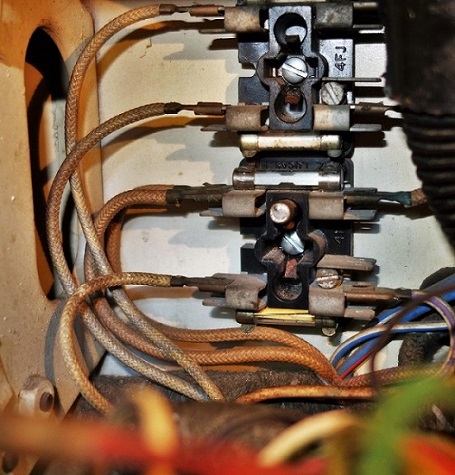
|
|
Fuse bank
Situated behind the center dash panel, which dropped down after removing two thumb screws, the fuse blocks were reasonably accessible.
The classical woven wire insulation covering is in very good condition, as is the original paint. This is one area of E-types where the original paint can usually be seen, even if the car has been thoroughly re-painted. An exception is a complete restoration where all the bodywork is repainted after the removal of all components.
|
|
|
|
|
|
Backup light
All but a few of the earliest E-types had their backup lights in the center of the rear of the car, above and between the exhaust pipe terminations.
With the introduction of the Series 2 cars, two smaller backup lights were used (one on each side of the license plate).
|
|
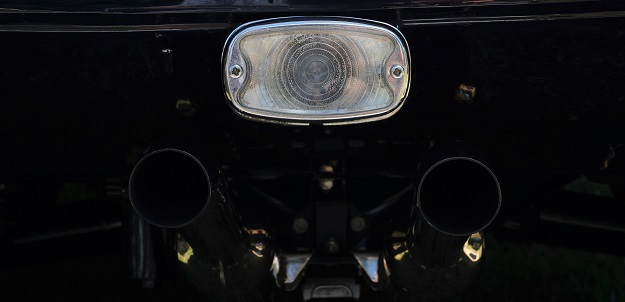
|
|
|
|
|
|
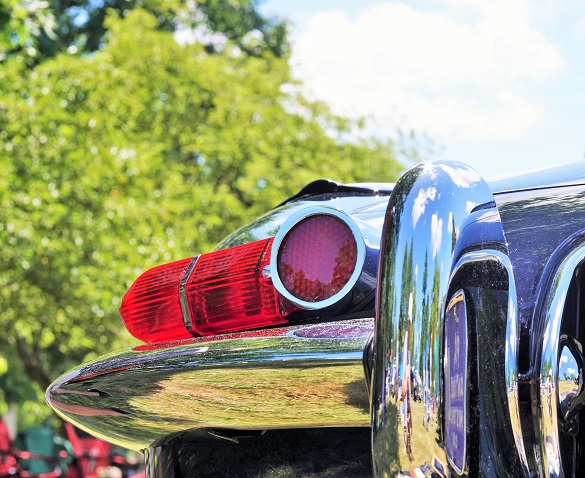
|
|
Series 1 tail light
The round lens is a reflector only; there was no light behind it.
|
|
|
|
|
|
Early necked-down covertible top clasp
These early clasps were very delicate and many broke. This is illustrated in the 3.8-liter clasp discussion on pagee 93 and 94 of the newOriginality Book.
They are rare items now.
|
|
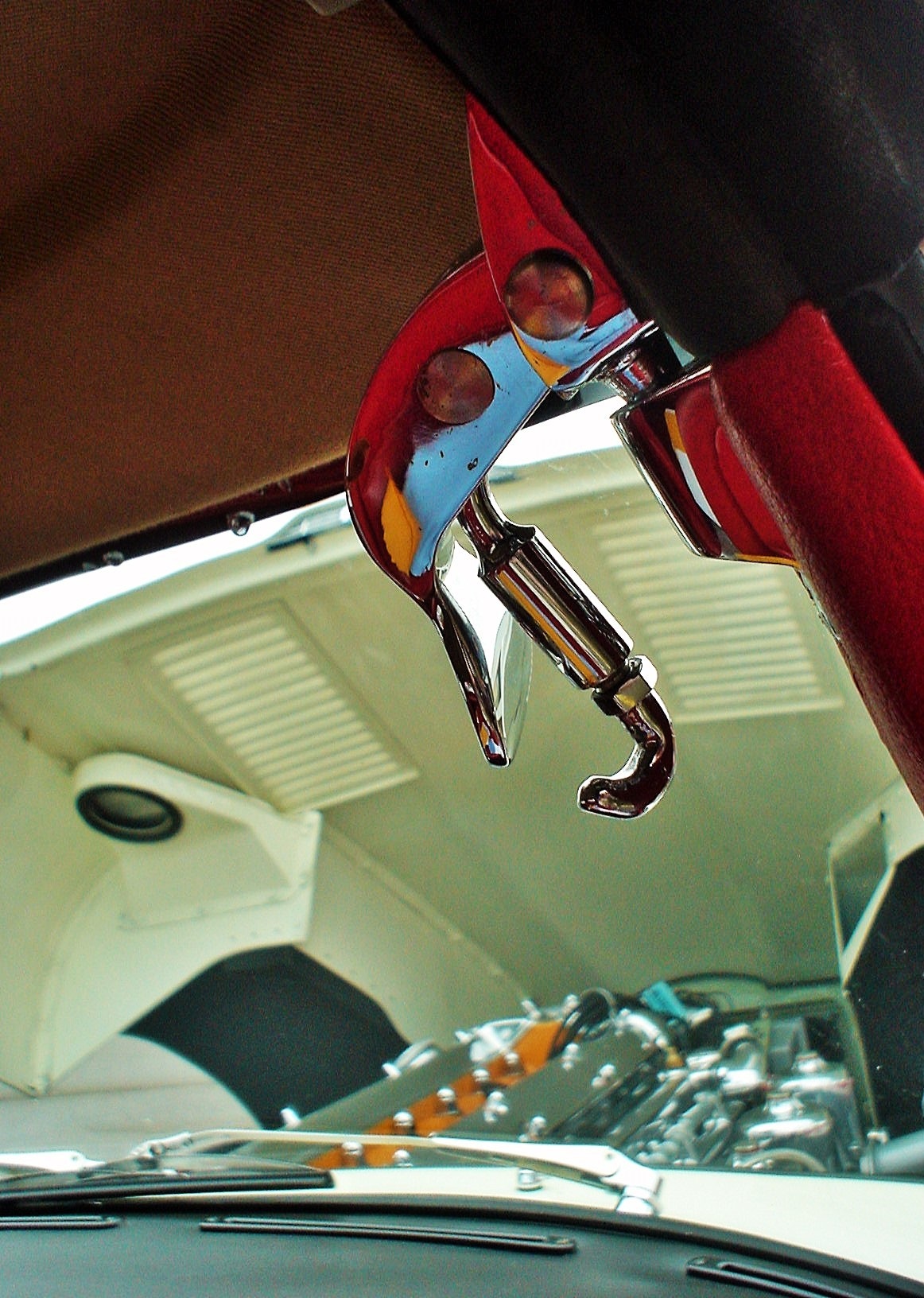
|
|
|
|
|
|
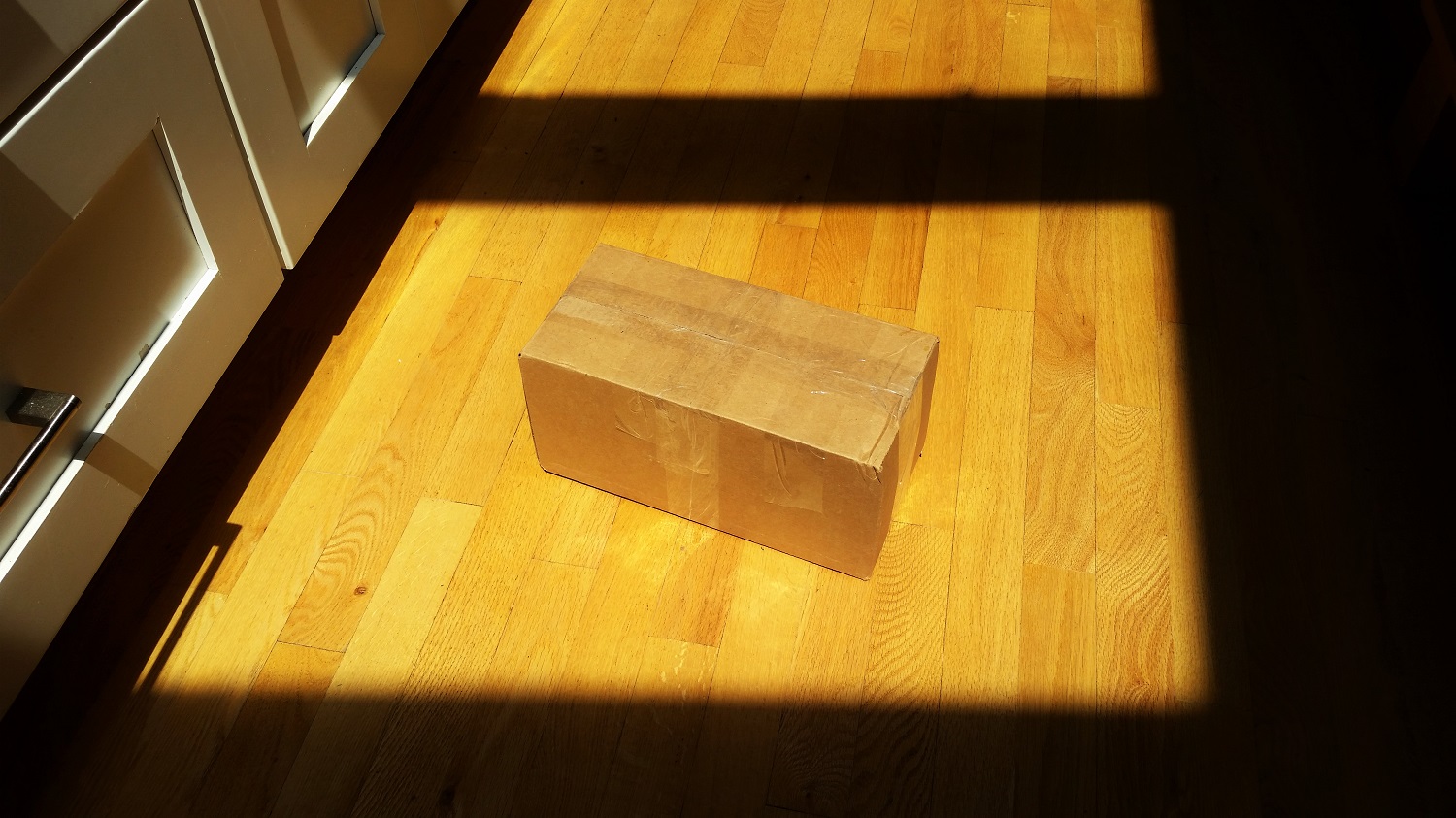
|
|
Box of E-type parts
A good deal of the fun of fixing old cars is locating the parts you need. Always exciting opening boxes of NOS or old used parts that arrive.
|
|
|
|
|
|
Parking lot at night
Early E-type engine in dim light showing the effects of the polished aluminum surfaces.
|
|
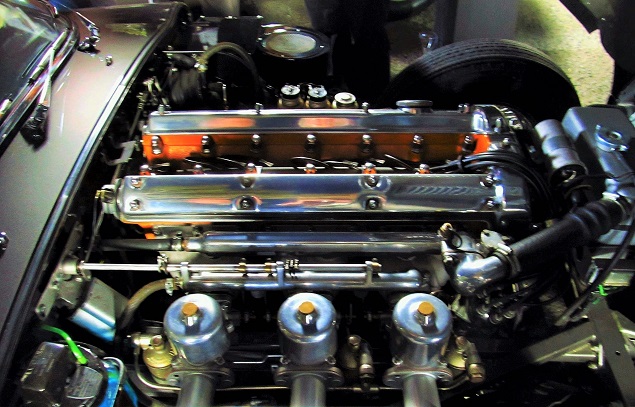
|
|
|
|
|
|
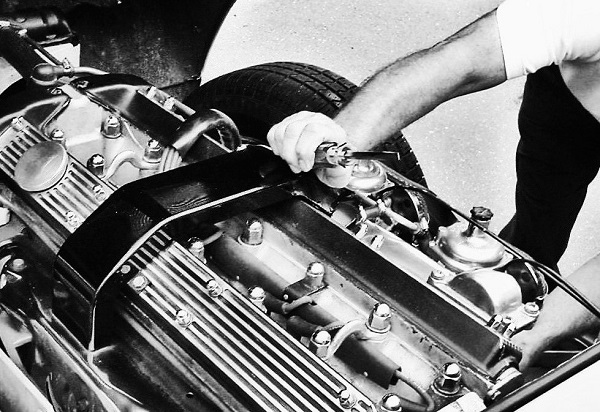
|
|
A drive in the country?
Attention required somewhere in the engine compartment.
|
|
|
|
|
|
Heater controls
The molded-on plastic handles often break off the heater controller levers.
|
|
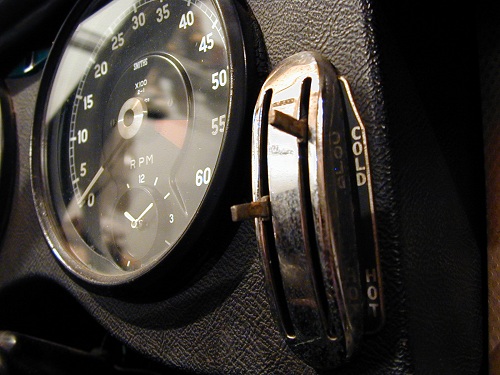
|
|
|
|
|
|
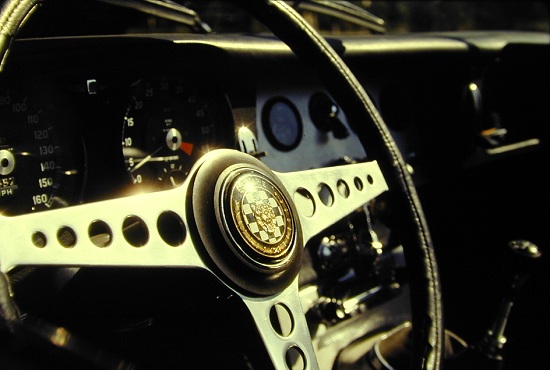
|
|
Leather-covered wood-rimed wheel
This after-market leather steering-wheel cover gives a softer feel than the wood rim.
|
|
|
|
|
|
Interior of distributor
An early 3.8-liter type distributor with points and condenser removed.
|
|
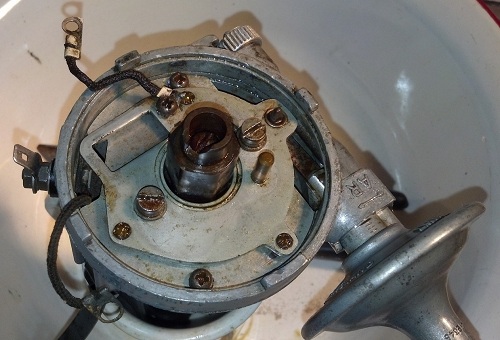
|
|
|
|
|
|
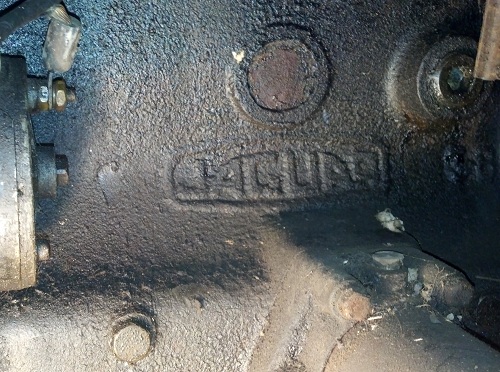
|
|
Engine block
A 3.8-liter engine showing years of road grime from the 1960s and 1970s
|
|
|
|
|
|
Waiting for judging
A 4.2-liter car awaits for judging under a plastic cover in the rain.
|
|
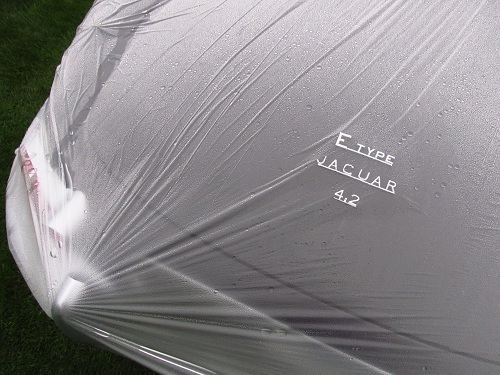
|
|
|
|
|
|
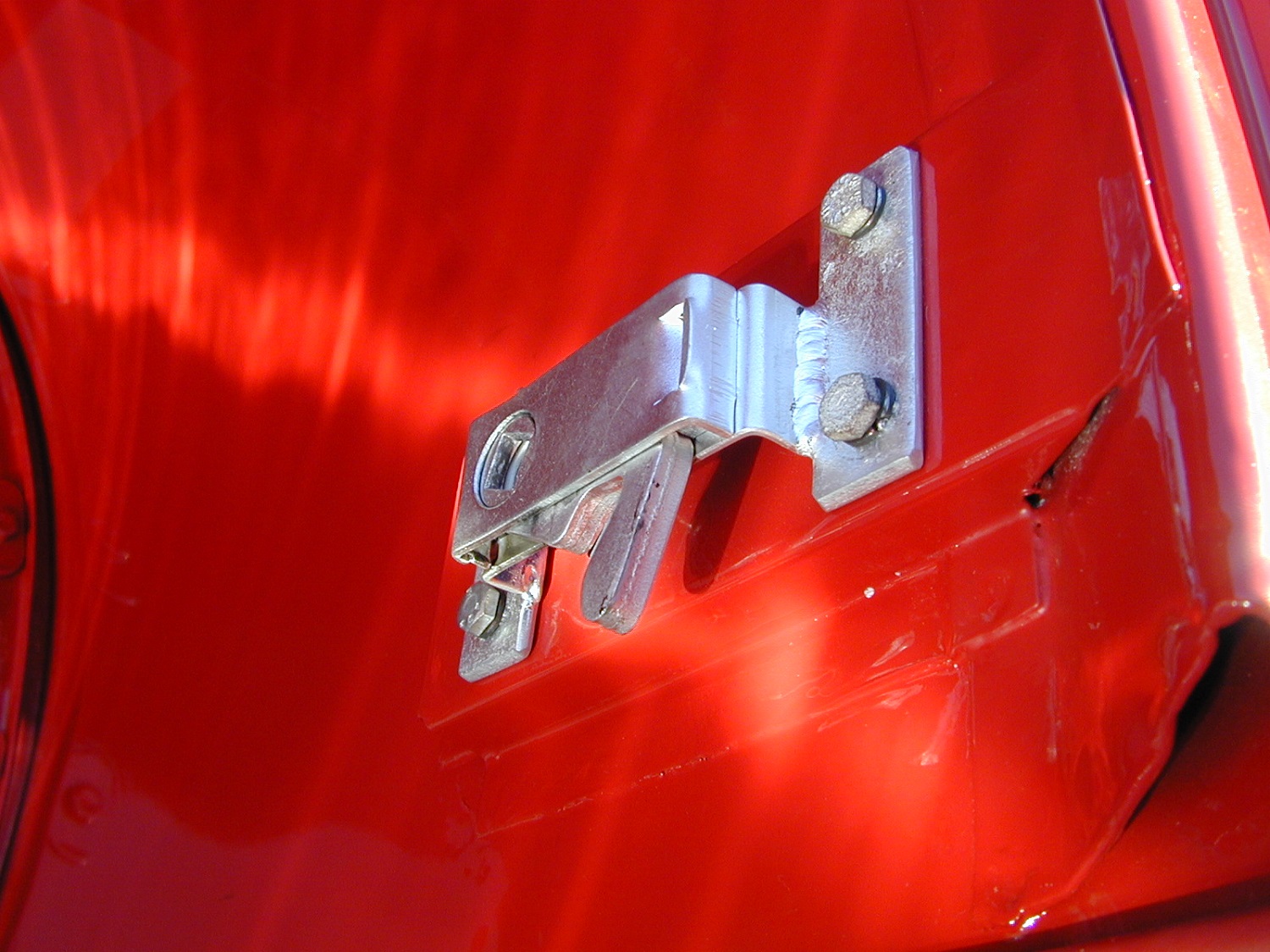
|
|
External latch mechanism
A restored latch mechanism from an external-latch car
|
|
|
|
|
|
Cheney clamp
Cheney hose clamps were among thosefitted to E-Types at the factory.
|
|
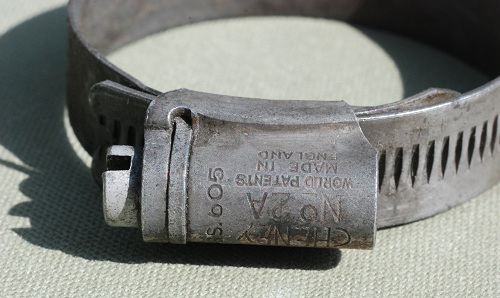
|
|
|
|
|
|
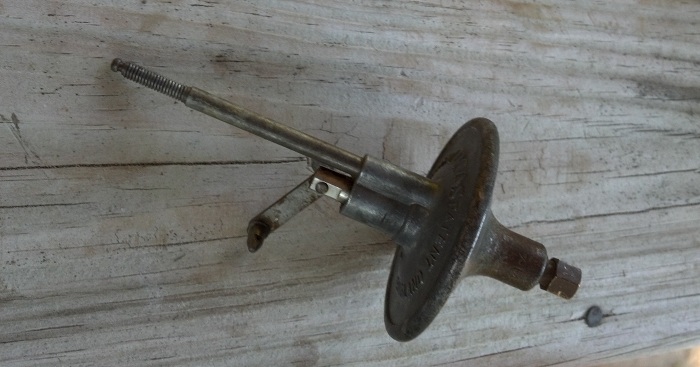
|
|
Vacuum advance
A vacuum advance chamber and rod from a 1962 E-Type.
|
|
|
|
|
|
Block casting markings
A casting date marking from a 4.2-liter block. This one was cast on March 31, 1967.
|
|
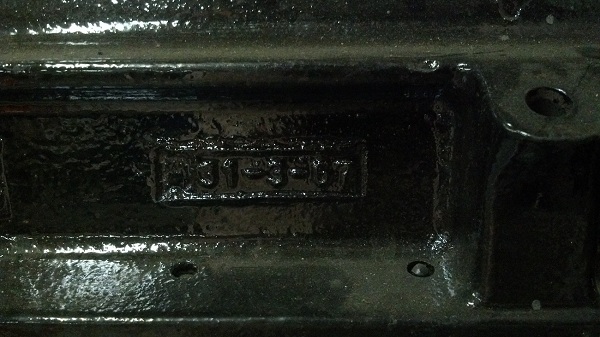
|
|
|
|
|
|
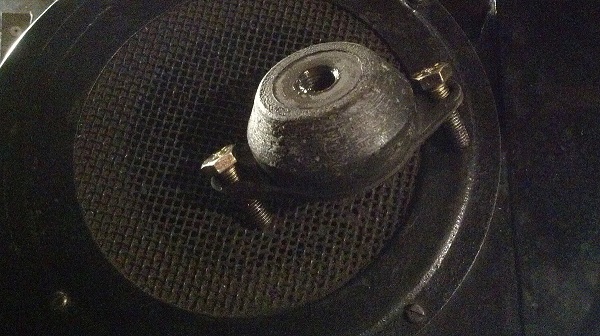
|
|
Engine mount
A replacement engine mount ready to be installed on an early 3.8-liter car.
|
|
|
|
|
|
Crankshaft
An XK engine crankshaft.
|
|
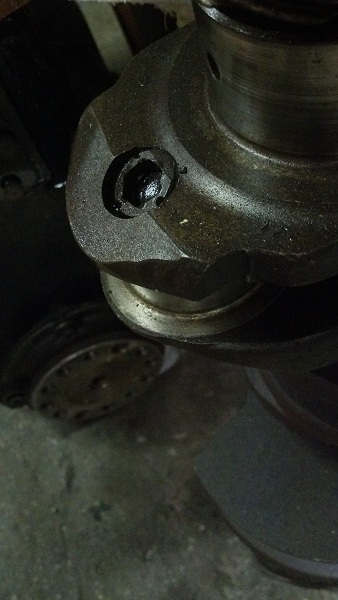
|
|
|
|
|
|
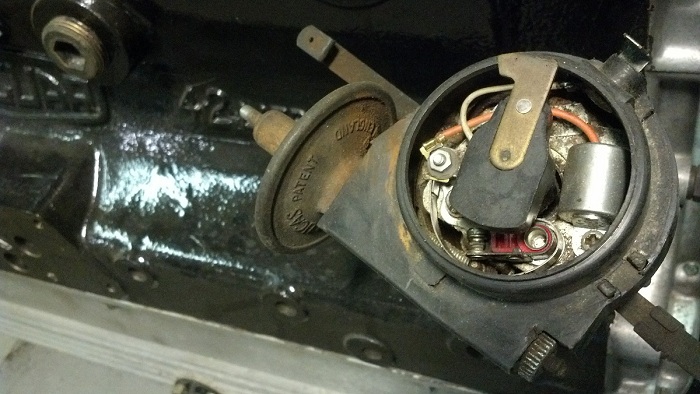
|
|
Series 1 4.2-liter distributor
The distributors on 4.2-liter Series 1 cars was configured very differently from the early 3.8-liter cars. For example, note the plastic shroud surrounding the top of the housing, just below where the distributor cap is fitted.
|
|
|
|
|
|
Early 3.8-liter type distributor
This distributor carries the date of February 1962. Note the lack of a plastic shroud as used in the 4.2-liter distributors.
|
|
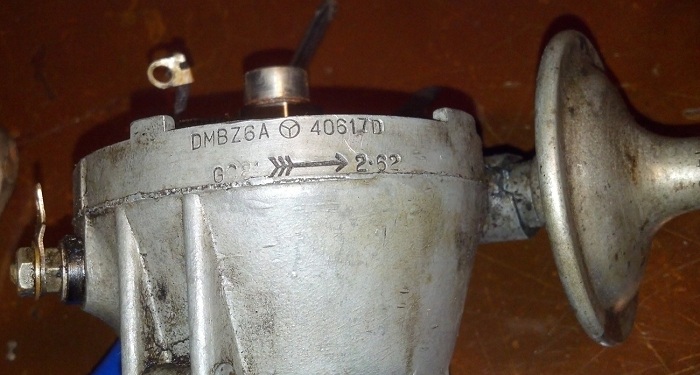
|
|
|
|
|
|
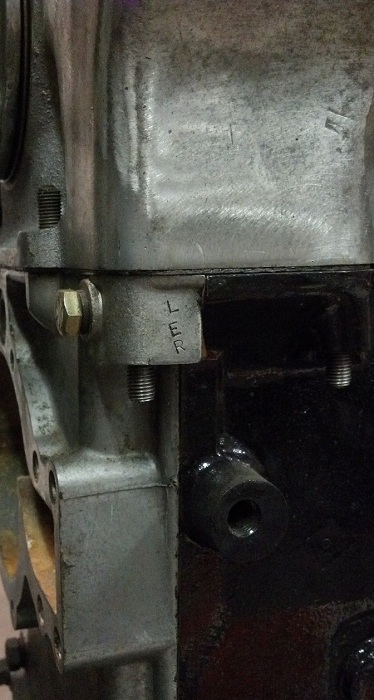
|
|
Stampings on a 4.2-liter engine's timing case
An example of the three letters stamped on the timing-chain case.
|
|
|
|
|
|
Armature from a late 3.8-liter type generator
This armature is from a 22902-type generator. These were used on later 3.8-liter E-types before being replaced by an alternator with the coming of the 4.2-liter cars.
|
|
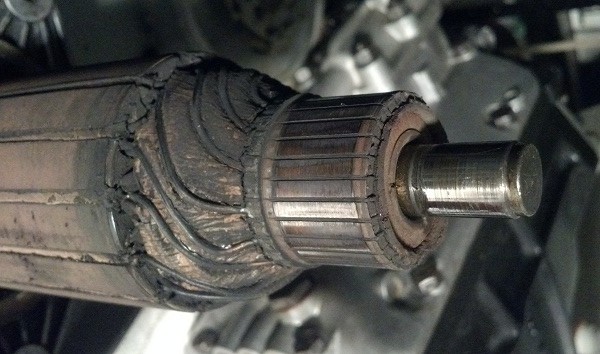
|
|
|
|
|
|
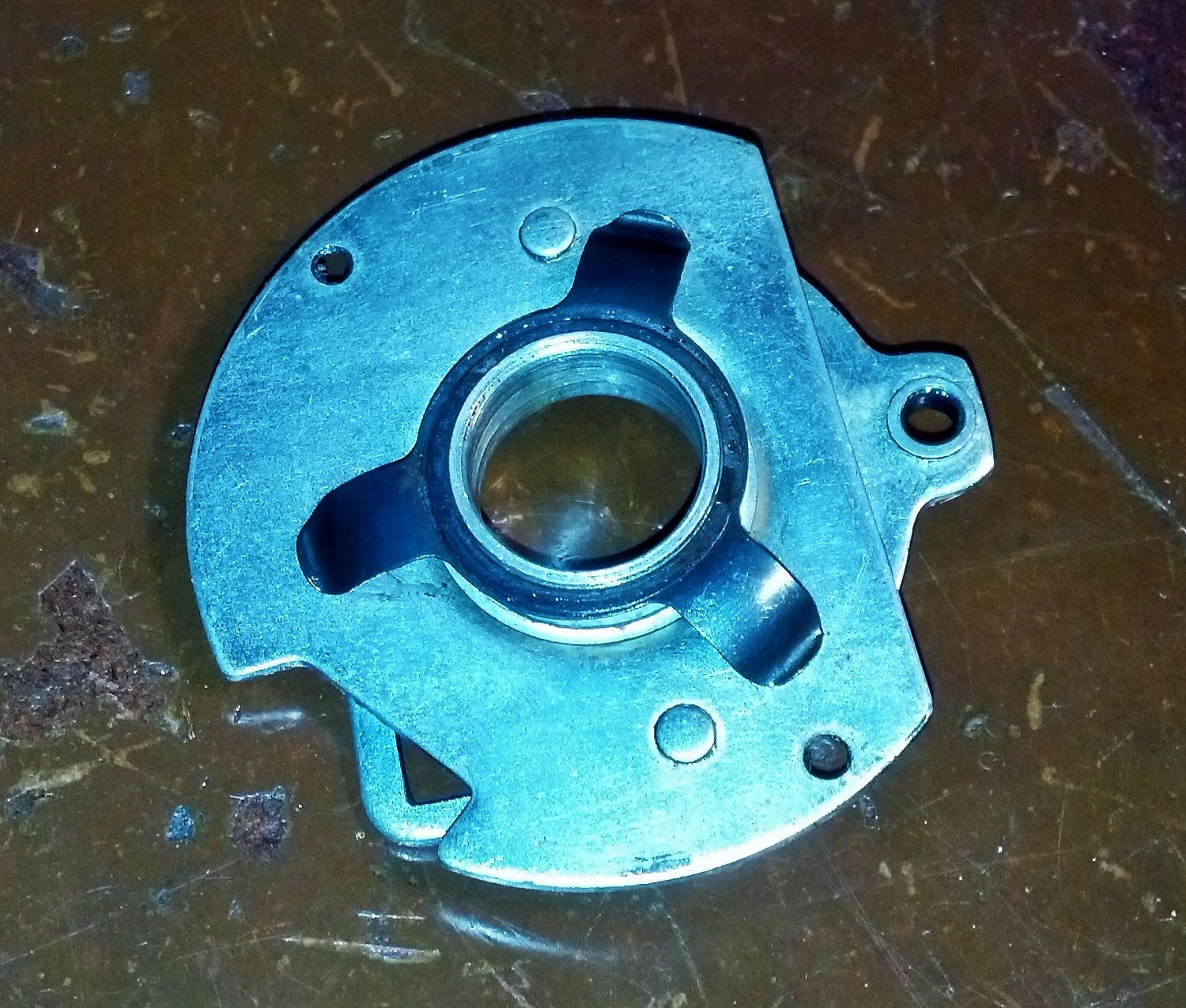
|
|
Beautifully preserved star spring
This orignal star spring from a 3.8-liter car has survived in essentailly perfect condition.
|
|
|
|
|
|
Late 3.8-liter car with a factory hardtop.
The standard factory hardtops were made of fiberglass, but had very good finishes.
|
|
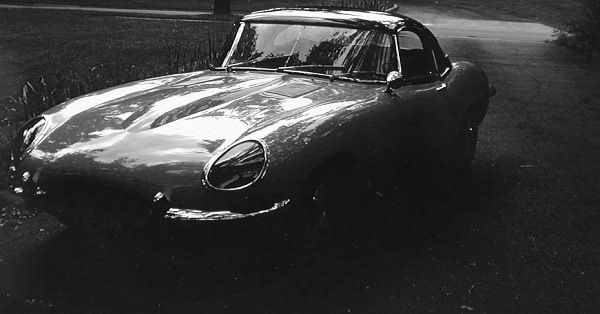
|
|
|
|
|
|
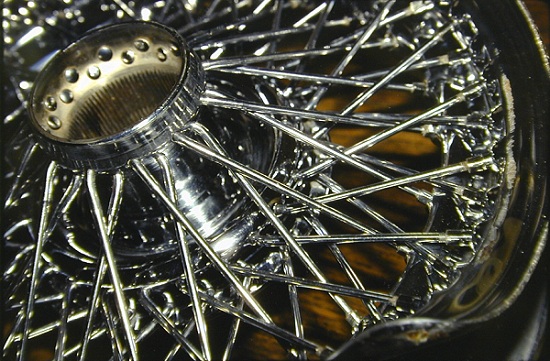
|
|
Early-style wheel
The all-steel, chrome-plated 72-spoke wire wheels had hubs bigger than those in contemporary sports cars. This wheel is damaged by a collision.
|
|
|
|
|

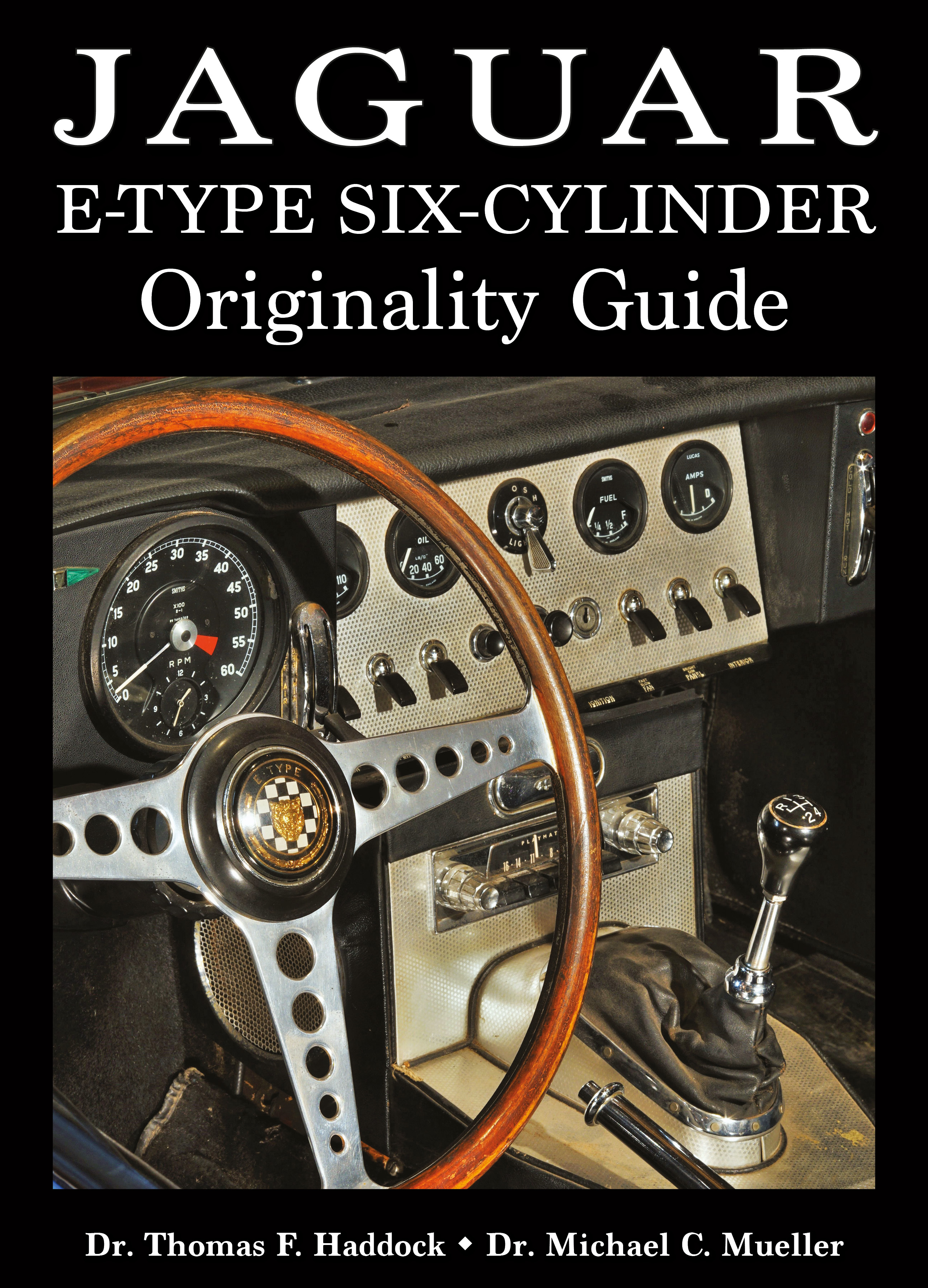







.jpg)

















